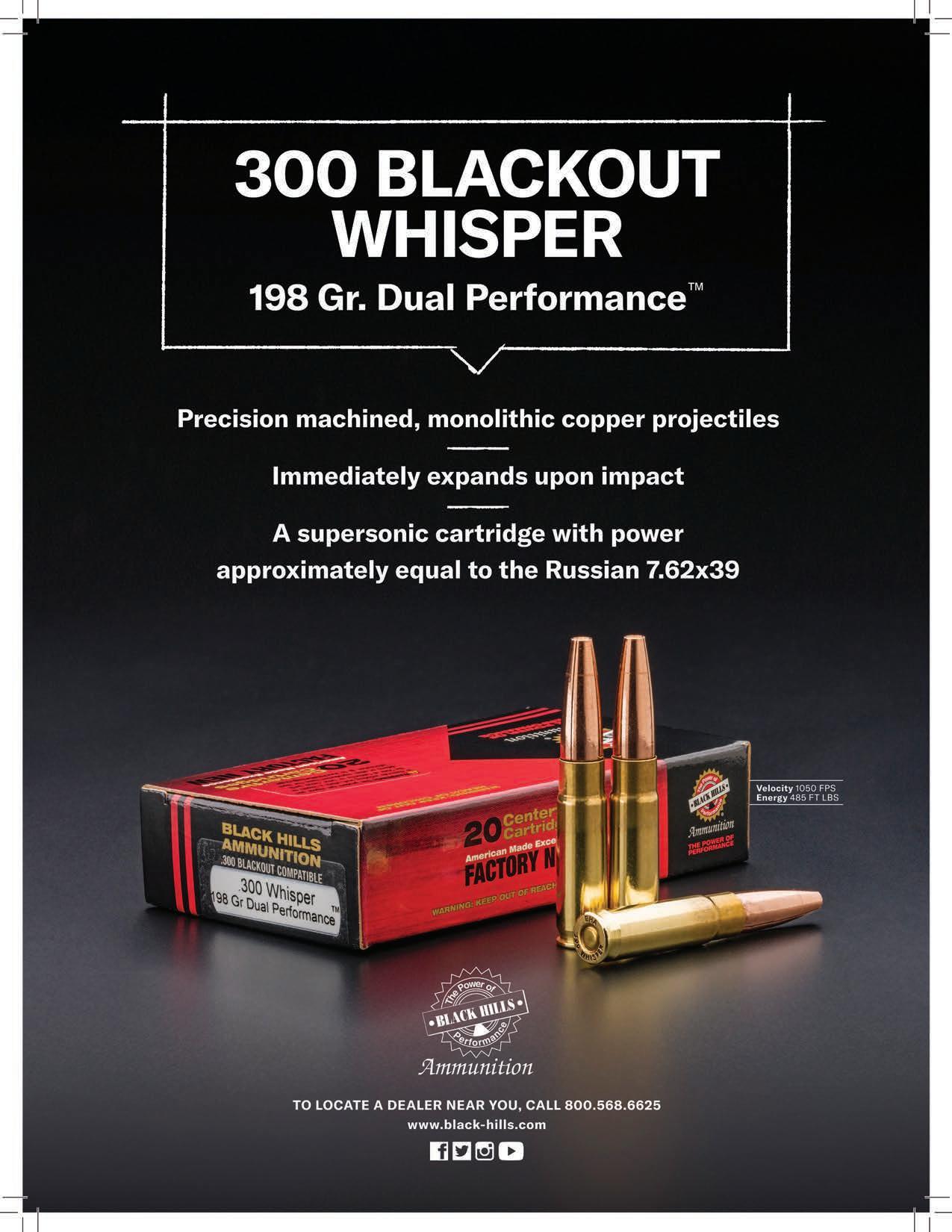



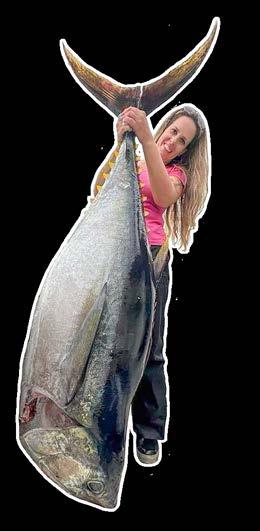














PUBLISHER
James R. Baker
GENERAL MANAGER
John Rusnak
EXECUTIVE EDITOR
Andy Walgamott
EDITOR
Chris Cocoles
WRITERS
Mark Fong, Scott Haugen, Tiffany Haugen, Tim E. Hovey, Cal Kellogg
SALES MANAGER
Paul Yarnold
ACCOUNT EXECUTIVES
Janene Mukai
DESIGNERS
Kha Miner, Gabrielle Pangilinan
WEB DEVELOPMENT/INBOUND
MARKETING
Jon Hines
ADMINISTRATIVE ASSISTANT
Katie Aumann
INFORMATION SERVICES MANAGER
Lois Sanborn
ADVERTISING INQUIRIES ads@calsportsmanmag.com
CORRESPONDENCE
Email ccocoles@media-inc.com X @CalSportsMan Facebook.com/ californiasportsmanmagazine
ON THE COVER
After two years of closures, California will get a modest inland king salmon season that opens on July 16. Stretches of just three Central Valley rivers – the Feather, American and Mokelumne – will be open for fishing, with a daily bag limit of one. “Even though it is a limited season, I am super excited to get back on the river,” says guide Brandon Abernathy, who shares fishing tips and tactics inside this issue. (ROD DOWN GUIDE SERVICE)



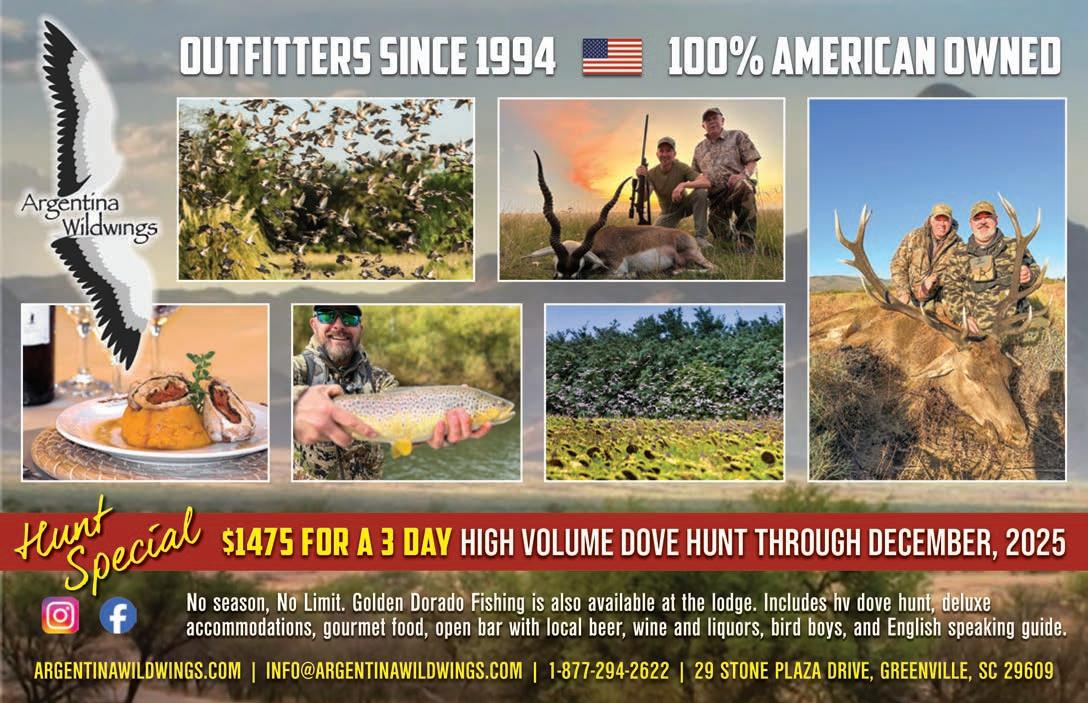
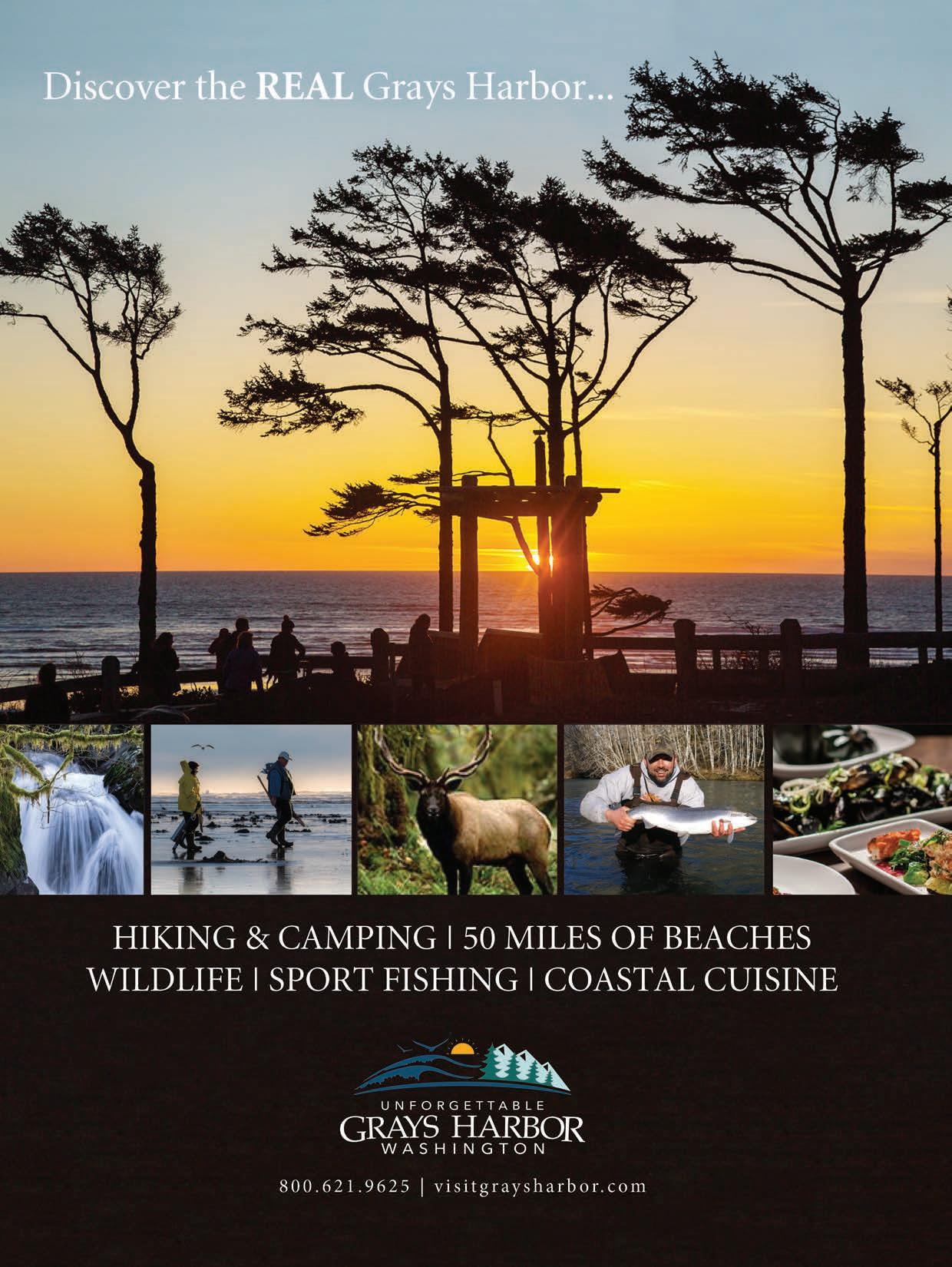

Whether your bag is limiting out on spring trout, soaking cut bait for summer catfish or tempting trophy brown trout in the fall, New Melones Reservoir provides Mother Lode anglers with some of the region’s best fishing through most of the calendar year. Cal Kellogg loves this fishery and helps with your planning to hit up a diverse destination.
After two frustrating years of essentially full closures, California anglers have a chance to catch king salmon again, first with a limited ocean season that saw the quota met in the first weekend, and now an inland fishery limited to sections of the Feather, American and Mokelumne Rivers. Mark Fong checks in with guide Brandon Abernathy for details on what to expect.
Scott and Tiffany Haugen’s summer of outdoor fun is here! Our From Field to Fire team has you covered with some of their favorite gear for camping trips and backyard cookouts. From portable coolers and drinkware, to a mosquito repeller and a handy cast-iron skillet, you’ll be ready to enjoy a Golden State adventure. Chef Tiffany also shares a tasty recipe to help clear out the big game meat in your freezer.
July 1 marks opening day for California’s cottontail rabbit season, and that day always fills Tim Hovey with nostalgia for his youth when he first hunted bunnies with a cousin’s borrowed lever-action .22. Decades later, Hovey has hunted these rascally rabbits with buddies and his now young-adult daughters, and he shows how you too can start a new tradition.

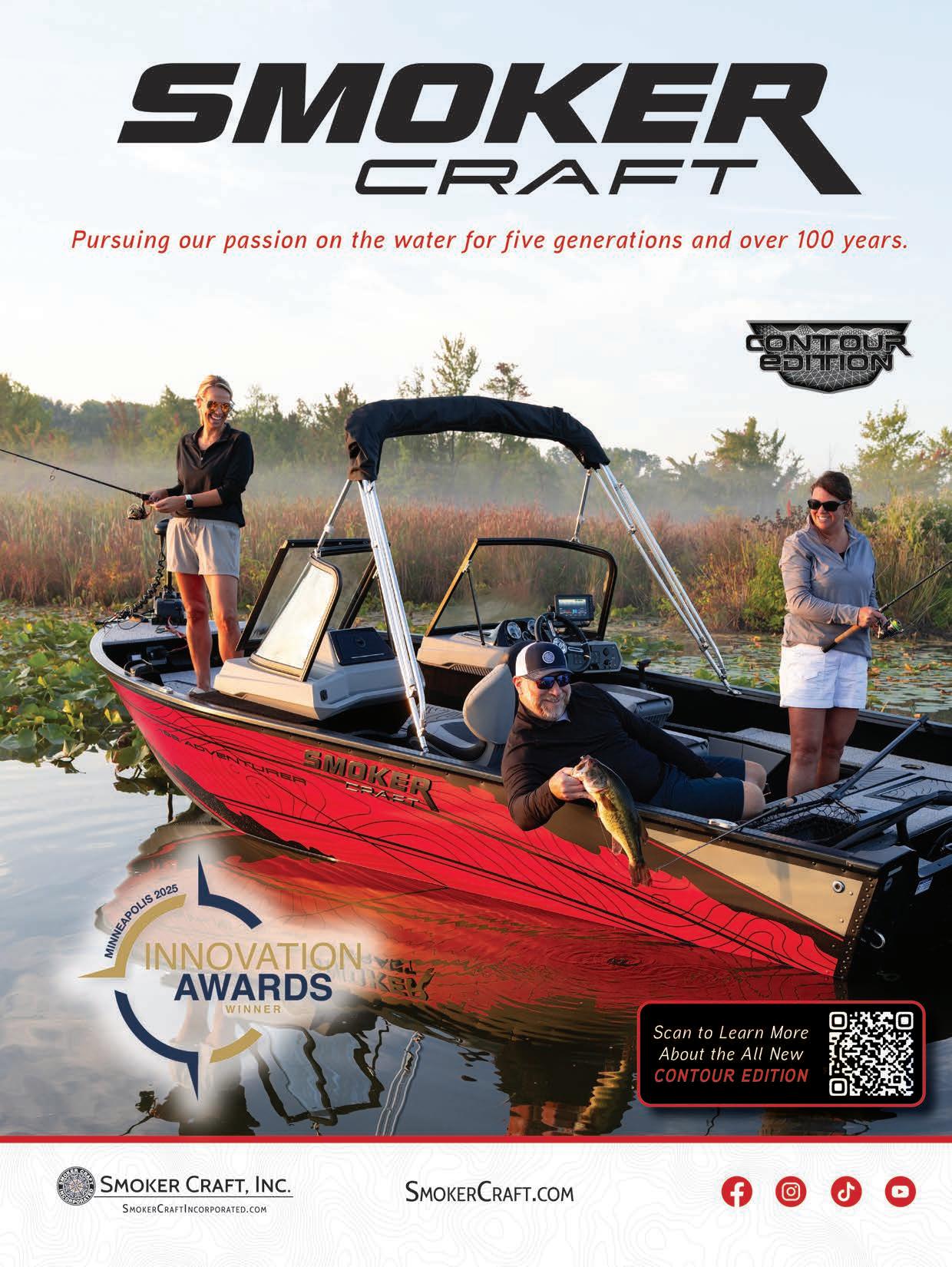
The editor’s Feather River king salmon adventures have become even more nostalgic as California deals with a crisis that saw two straight years of total fishing closures for the species. For 2025, a restricted inland season is set to begin on July 16. (CHRIS COCOLES)
In early June, I received a weekend email with an attached social media photo of a boat full of happy Bay Area anglers holding up limits of gorgeous king salmon.
I almost had to do a double take that it was indeed from the 2025 opening weekend of ocean salmon season in California waters. That’s because the last two years of full fishing closures have made us all feel a range of emotions – from frustrated to angry to melancholy – in the wake of crashed stocks and ensuing finger pointing about how a once robust fishery managed to become so bleak and on the verge of catastrophe.
“This is more than just a fishing opener – it’s a symbolic return of a cherished tradition and a vital way of life,” Scott Artis, executive director of the Golden State Salmon Association, said when recapping an opening weekend so productive that the harvest goal was met quickly and shut down the rest of the first set of ocean dates. Fishing will resume again in the fall.
“But make no mistake: This year’s limited season reflects the ongoing damage caused by failed state water policies that continue to push our salmon runs to the brink of collapse,” Artis added.
Well stated, and there are some who felt that fishing should have been shut down for another year in hopes of restoring runs back to North Coast and Central Valley rivers. But we make do, and as our correspondent Mark Fong writes this month (page 29), a limited inland season will commence on July 16 with fishing opportunities on the Mokelumne, Feather and American Rivers.
The Feather will always have a special place in my heart. I was joined by Fong and our late friend, guide Manny Saldana, on the trip when I caught my first river Chinook almost a decade ago. It
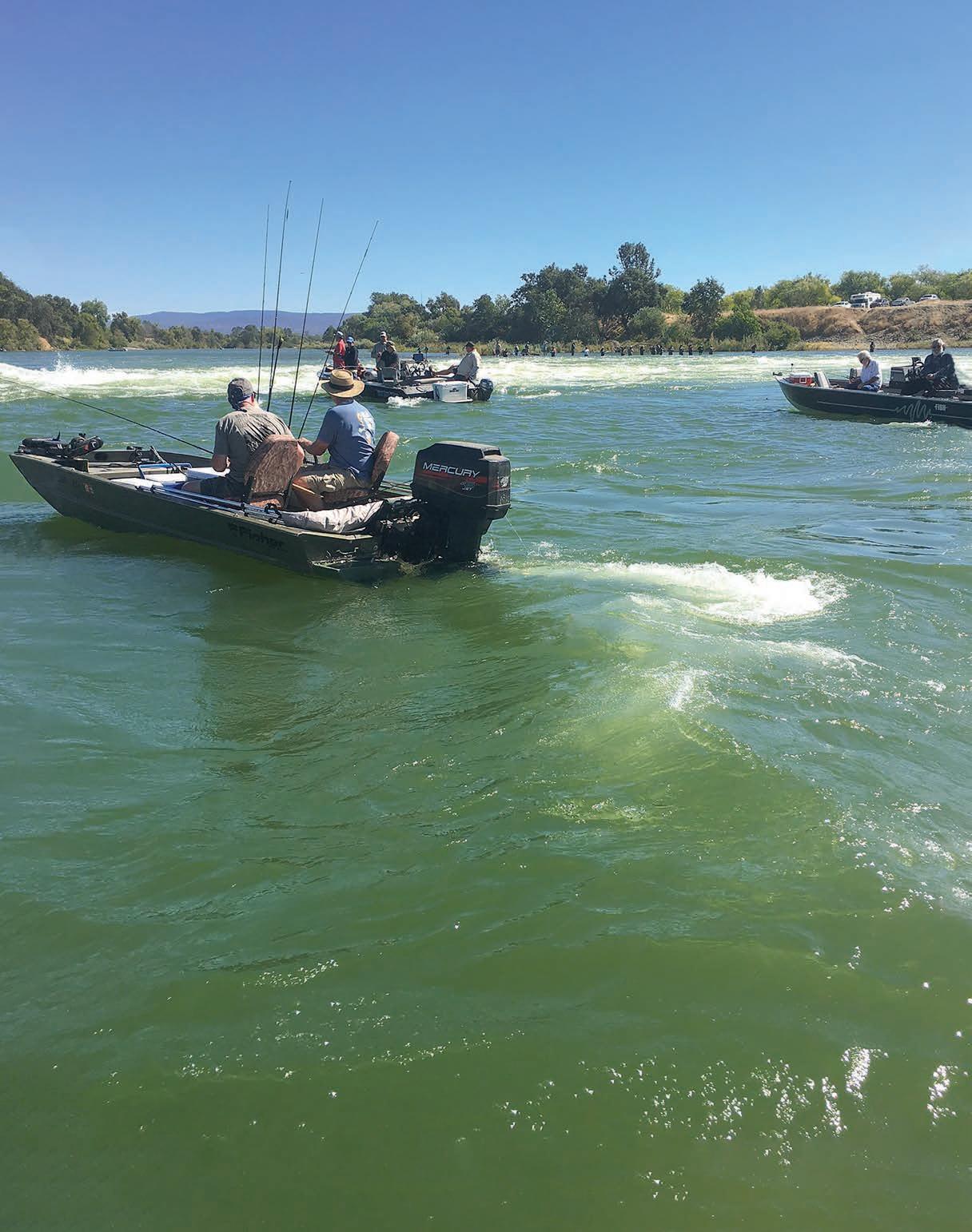
was a great moment for me personally as an angler, catching a fish that had taken such a remarkable journey out to sea, then back through the Golden Gate and San Francisco Bay and the maze of the Delta before it reached the Feather. I felt honored to be on the river that day.
A couple years later I joined Saldana again, this time to fish the chaos of Thermalito Afterbay. We drifted roe in and out of the fast current with more than a dozen other boats, plus a gaggle of shore anglers trying to tempt kings. We only landed one keeper that day, but it was still something I can look back on fondly.
So here we go with a reduced season this month, and despite the closures on the iconic Sacramento and coastal classic rivers such as the Klamath, good luck to all of you as you head out for a rite of passage that we’ve all missed. The salmon are waiting for you. -Chris Cocoles
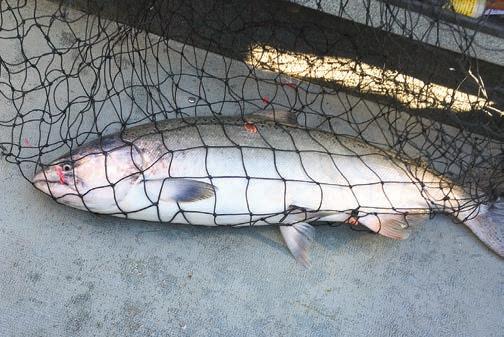

1 R abbit and varying hare hunting season opens
1-31 How Big Is Big Fishing Derby, West Walker River; northernmonochamber .com/events
4 Fishing Expo, June Lake; monocounty.org/event/june-lake-4th-of-julyfishing-expo/8430
5 Free Fishing Day in California, no general license required in state waters; wildlife.ca.gov/Licensing/Fishing/Free-Fishing-Days
5-6 Ocean salmon fishing open days (California-Oregon border to U.S. Mexico border; dependent on available quota)
12 Phil Johnson Memorial D on Pedro Lake Team Kokanee Derby; kokaneepower.org
12 Zone A archery deer hunting season opens
16 Opener of limited inland salmon fishing season on the Feather, American and Mokelumne Rivers
19 California Halibut Derby, Humboldt Bay; ncgasa.org/product/ california-halibut-derby/
26 Kids Fishing Festival, Mammoth Lakes; monocounty.org/event/kidsfishing-festival-mammoth/7050
26 Zone B-4 archery deer hunting season opens
26-27 Ultimate Frog Challenge, Russo’s Marina, Bethel Island; anglerspress .com/events/ultimate-frog-challenge
26-Aug. 3 Fort Hunter Liggett archery tule either-sex elk hunting season dates
1-2
Bridgeport Fish Fest, Twin Lakes Resort; twinlakeresort.com
2 Stampede Reservoir Team Kokanee Derby; kokaneepower.org/ derbies.php
9 Zone A (South Unit 110 and North Unit 160) general deer hunting season opens
9-17 O wens Valley multiple zone archery tule bull elk hunt dates
12-15
14-17
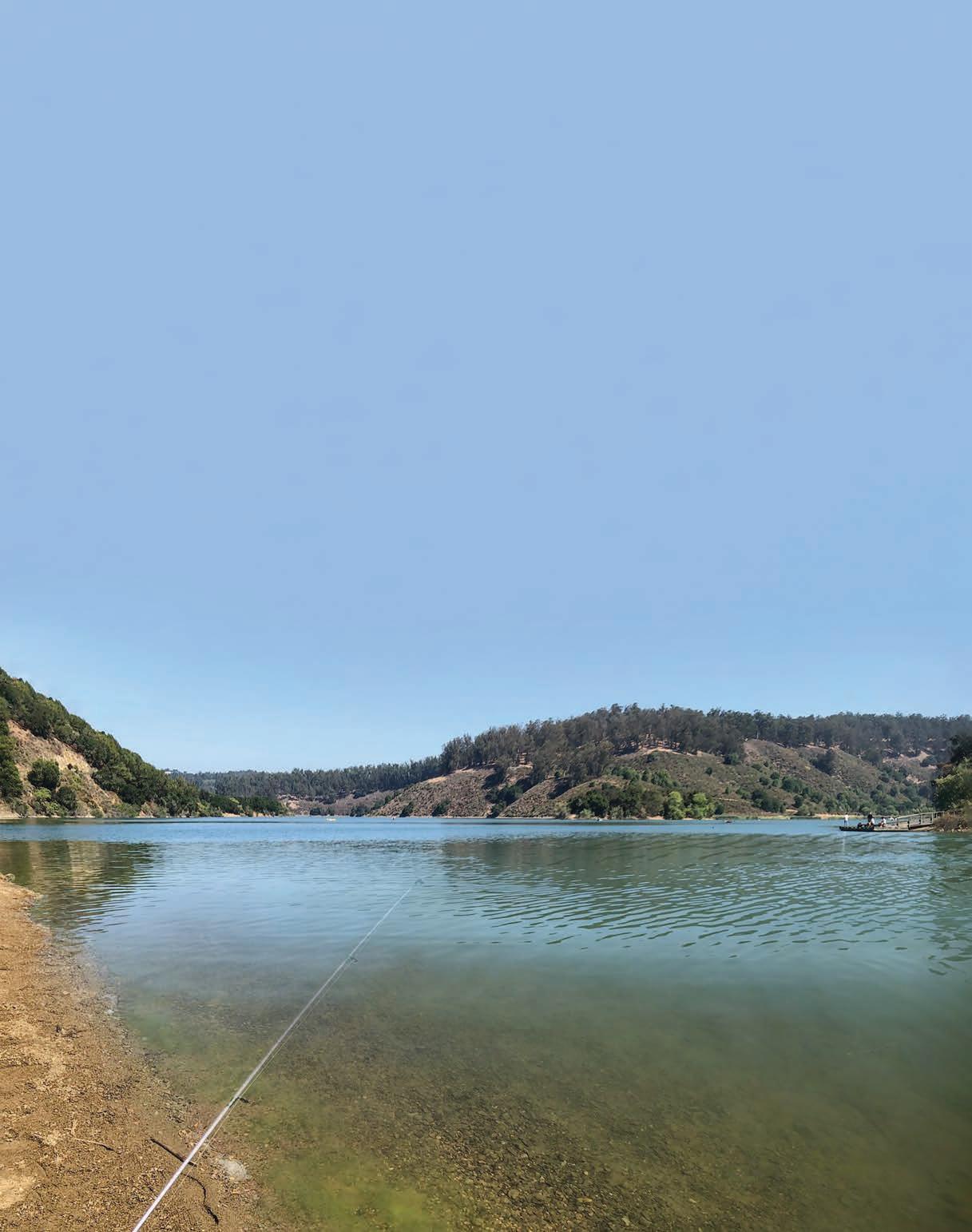
Grizzly Island period 1 apprentice antlerless general tule elk hunt
Grizzly Island period 2 apprentice spike bull tule elk hunt
16 Zones B-1, B-2, B-3, B-5 and B-6 archery deer hunting seasons open
16 Zones D-3 through D-10 archery deer hunting seasons open
22 Start of Ambush at the Lake fall fishing derby, Convict Lake; convictlake.com or (800) 992-2260
23 Zone B-4 general deer hunting season opens
23-31 Most pronghorn antelope general, apprentice hunting season dates
27-Sept. 9 Siskiyou archery Roosevelt bull elk hunt dates
30 Free Fishing Day in California, no general license required in state waters; wildlife.ca.gov/Licensing/Fishing/Free-Fishing-Days
For a list of upcoming bass tournaments, go to nrm.dfg.ca.gov/FishingContests/ default.aspx.
Note: General bear season opens concurrently with general deer season in the A, B, C, D, X8, X9A, X9B, X10 and X12 deer hunting zones and extends through December 28, 2025. For those portions of zones X1, X2, X3a, X4, X6a, X6b, X7a and X7b open to bear hunting, the general bear season begins October 11, 2025, and extends through December 28, 2025.
The first of California’s 2025 free fishing days - no general license required – is set for July 5. Check out wildlife.ca.gov/licensing/ fishing/free-Fishing-days for more information. (CHRIS COCOLES)

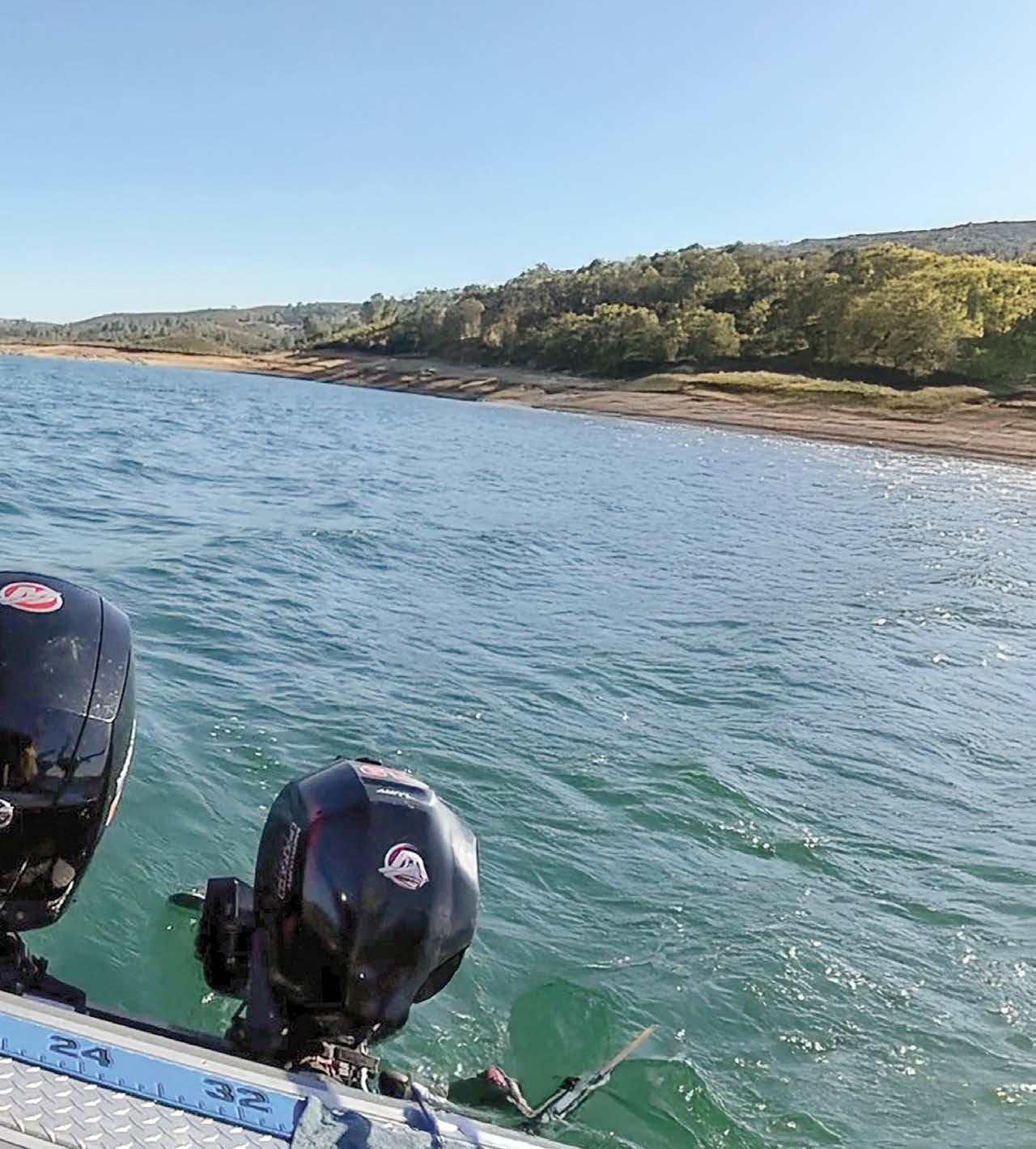
By Cal Kellogg
New Melones Reservoir is the crown jewel of the Mother Lode region, a sprawling aquatic playground steeped in history, surrounded by natural beauty and offering anglers some of the most diverse fishing opportunities in the state. Whether you’re casting from a kayak, trolling from a deep-V trout and salmon sled or walking the shoreline with rod in hand, New Melones delivers.
Spanning more than 12,500 surface acres at full pool and boasting over 100 miles of shoreline, New Melones is the fourth-largest reservoir in California. It sits at the confluence of two storied waterways: the Stanislaus River and Angels Creek. The lake was created by the construction of New Melones Dam, a towering rockfill structure completed by the U.S. Army Corps of Engineers in 1979 and later transferred to the Bureau of Reclamation. The dam was built primarily for flood control, irrigation storage and hydroelectric power generation, replacing the original Melones Dam, which was built in 1926.
At 625 feet tall, New Melones Dam is one of the tallest in the state, holding back up to 2.4 million acre-feet of water when the lake is full. That massive volume provides a stable environment for a thriving aquatic ecosystem and supports a wide array of gamefish.
New Melones is best known for its prolific populations of rainbow trout, kokanee salmon and black bass, but that’s just scratching the surface. Along with spotted, smallmouth and largemouth bass, the reservoir also holds brown trout, channel catfish, crappie and bluegill, making it a legitimate multispecies fishery.
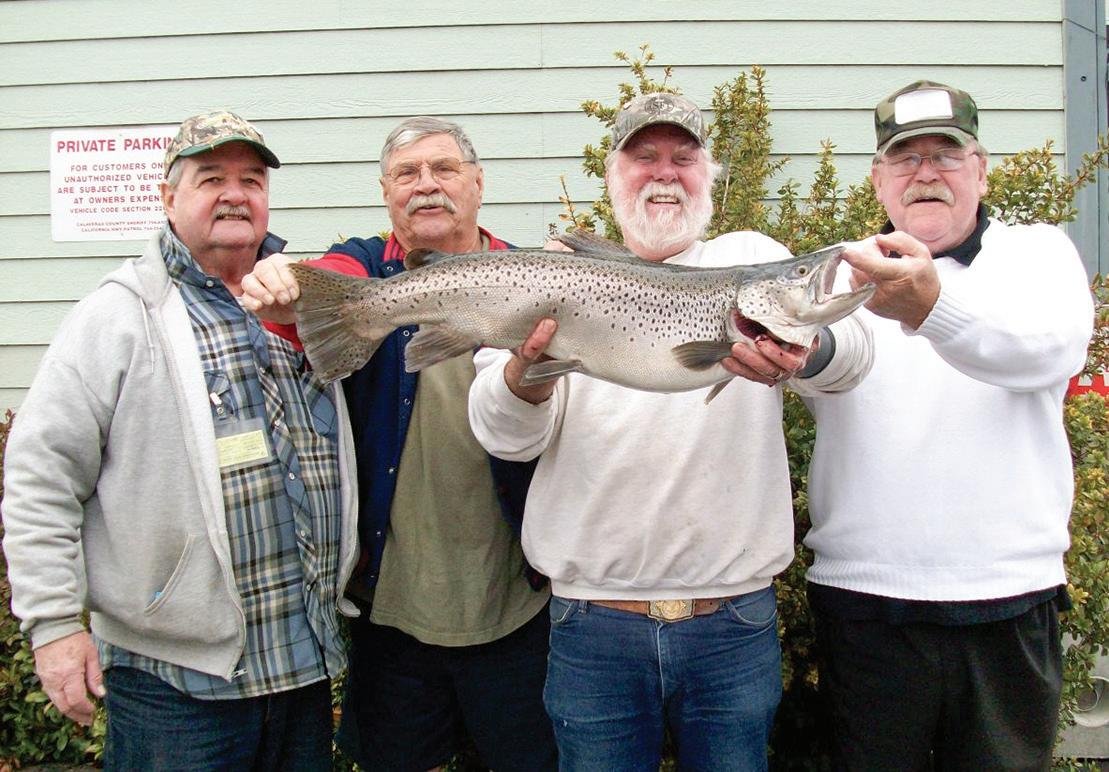
For coldwater anglers visiting New Melones, rainbows and kokanee provide lots of excitement, but it’s the prospect of hooking one of the lake’s trophy brown trout that kicks the imagination of trollers into high gear.
Browns in the 6- to 8-pound class, while difficult to catch, are relatively common and the lake’s biggest appear to top out at around 13 pounds.
Since 2010, three New Melones browns in excess of 13 pounds have been recorded. Jim Harlan set the then lake record with a massive 13.1-pound brown back on February 11, 2010. Harlan’s standard held the top spot until 2011, when Michael Oliveria nailed a 13.4-pound brown that December.
Then in January 2022, Bobby Aperoch matched Oliveria’s mark with a 13.4-pound brown of his own.
Brown trout at New Melones are opportunistic feeders, preying heavily on planted rainbows, kokanee and schools of threadfin shad. They’re most active in low-light conditions – early mornings, late evenings or overcast days – and are commonly caught near the dam, Angels Creek and upriver channels, especially in colder months.
Your best shot at a trophy brown comes during winter and early spring, when surface temperatures are cool and the big fish move into the shallows. Trolling large plugs such as Rapalas, J-Plugs or custom-painted minnow baits that mimic rainbows or kokanee is the go-to technique. Focus on points, contour breaks and deep-water transitions. Leadcore line, downriggers or flatlining long distances behind the boat all have their place depending on the season and conditions.
Casting big swimbaits and soft jerkbaits from the bank or a kayak in the predawn hours can also pay off. Browns love ambush zones – shadow lines, submerged trees and current edges – and prefer structure-rich environments.
Patience is critical when pursuing browns. You might troll for hours or days without a bite, but when a New Melones brown hits, it hits with the kind of force that turns heads and snaps gear. Many anglers go years between big browns, but the reward of landing a double-digit trout makes it all worthwhile. Targeting browns at New Melones is not about numbers; it’s about hunting one big, smart and heavy fish. For those willing to put in the time, it’s one of the lake’s most satisfying challenges. -CK
Spring marks one of the most exciting times to be on the water. As the surface temperature begins to rise, rainbow trout move shallow to feed on baitfish, aquatic insects and terrestrial offerings washed in by spring runoff. Trollers score with spoons, spinners and small plugs fished in the top 20 feet of the water column, while shore anglers do well casting Kastmasters or soaking PowerBait off points and coves near the Tuttletown and Glory Hole Recreation Areas.
New Melones is known as one of California’s top kokanee fisheries – and for good reason. The lake’s depth, clarity, stable thermocline and robust zooplankton base make it a perfect habitat for kokanee to grow fast, fight hard and feed consistently. With depths exceeding 300 feet and cool, oxygen-rich water through summer, New Melones gives kokanee everything they need to thrive.
The California Department of Fish and Wildlife stocks kokanee annually, and most fish reach 12 to 16 inches by midsummer thanks to those ideal conditions, with some pushing 18 inches in strong years. These landlocked sockeye are a schooling fish, so once you find one, you’ve likely found many.
In spring, target kokanee 15 to 30 feet down with small spoons, spinners or hoochies behind dodgers. Pink, orange and chartreuse are staple colors. As summer progresses and surface temps climb, kokanee drop deeper – often 50 to 80 feet – and that’s when downriggers become essential.
Troll at 1.1 to 1.5 mph and always tip your lures with dyed and scented white shoepeg corn. Garlic, anise or krill scents are proven additives, which can make the difference when the bite gets tough.
Use your sonar to find schools of kokanee, which are marked as tight, suspended clusters in open water, often near the dam, Rose

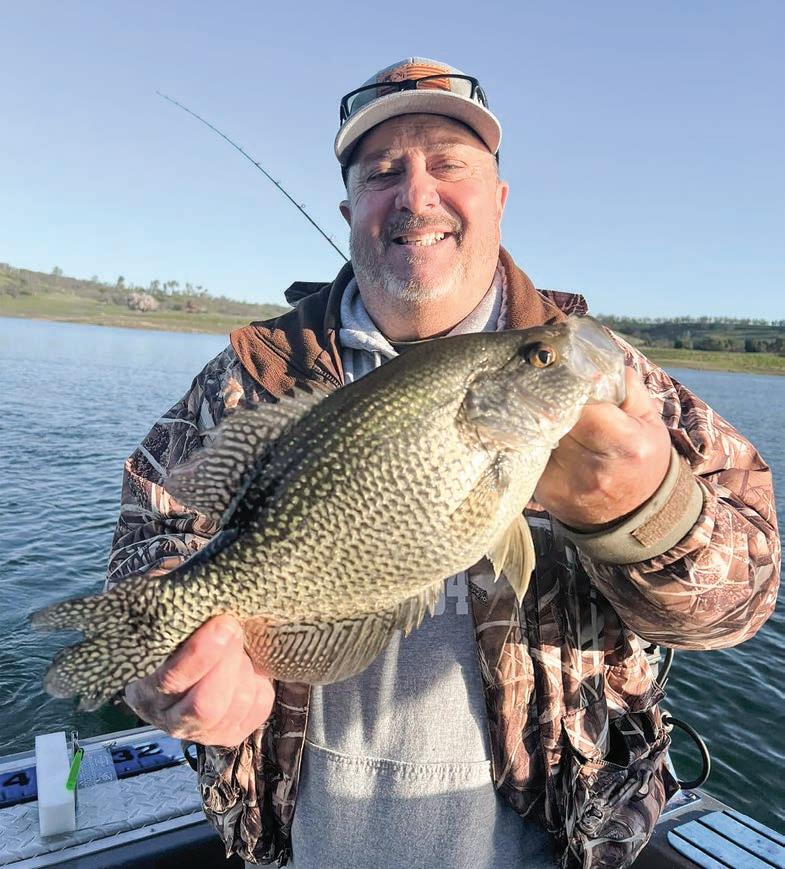
From

Island or the spillway. Adjust your depth and lure color until you crack the pattern.
Kokanee at New Melones are known for their ferocious fights and delicious orange-red meat. They’re not always easy to figure out, but when you dial in the depth, color and speed, few fisheries are as fast or rewarding. For precision anglers who love tinkering with gear and dialing in details, New Melones offers one of California’s best kokanee challenges.
BASS, CATFISH BONANZA
Summer is also prime time for bass anglers. Largemouth cruise the shallows early and late in the day, hammering topwater frogs and buzzbaits, while spotted bass – the dominant black bass species in the lake – roam in open water and around submerged structure. Dropshot rigs, finesse jigs and swimbaits all produce consistent action. Because of its depth and clarity, New Melones supports an excellent spottie fishery, with 2- to 3-pounders common and 5-pound fish caught every season.
New Melones is also one of California’s most underrated catfish destinations. With its vast size, warm summer water temps and abundant forage, the lake grows quality channel catfish that are available year-round, with peak action from late spring through early fall.
Catfish in New Melones often hold along mudflats, creek channels and rocky shorelines – especially near the Glory Hole and Tuttletown Recreation Areas. Night fishing is particularly productive, as cats become more active in low light, cruising shallows for crawdads, minnows and dead bait.
Top baits include cut anchovies, chicken liver, sardines, mackerel and dough baits, fished on sliding sinker rigs with 1/0 to 3/0 hooks. For trophy-class cats, try soaking large chunks of oily bait after dark near submerged trees or dropoffs.
While most fish run 2 to 8

pounds, double-digit channel cats are caught every season. Anglers looking for simple, consistent action will find New Melones catfish both accessible and rewarding, fishing from either the bank or a boat.
New Melones Reservoir offers some of the best crappie fishing in the Sierra foothills, especially during the spring spawn. As water temperatures climb into the 60s, crappie move into shallow coves, brush piles and submerged timber to spawn, creating fast-paced action for anglers in the know. Most fish average 10 to 12 inches, but slabs over 14 inches are caught each season. Light spinning tackle and 2- to 4-pound-test line are ideal for presenting small jigs, tubes or curl-tail grubs in white, chartreuse
and pink. Live minnows under a slip bobber also can be highly effective, especially around structure. Look for fish around Glory Hole Cove, Angels Creek and upriver arms with submerged wood. As summer progresses, crappie transition to deeper brush and ledges, where vertical jigging or slow trolling pays off. Whether fishing from a boat or kayak, New Melones is a top destination for tasty, hard-fighting crappie.
Fall ushers in some of the year’s best trout fishing, as cooling water temperatures bring fish back to the shallows and trigger a prewinter feeding frenzy. October through December is a top window for anglers looking to hook into chunky holdover rainbows or intercept a
trophy brown trout – particularly near the dam and upriver arms. Slow trolling with Rapalas, Needlefish or nightcrawler/Wedding Ring combos can be deadly during this period.
Winter doesn’t put a stop to the action. In fact, serious trout anglers know that New Melones can produce some of its largest fish during the colder months. With less boat traffic and stable lake levels, targeting the main river channels with leadcore or downriggers can put anglers on quality trout all the way through February.
My most recent New Melones fishing adventure took place in June, when R.J. Sanchez and I joined up with Brian Thomas of Three Sons Guide Service (916-2305324). We hoped to hammer some landlocked sockeye, and hammer
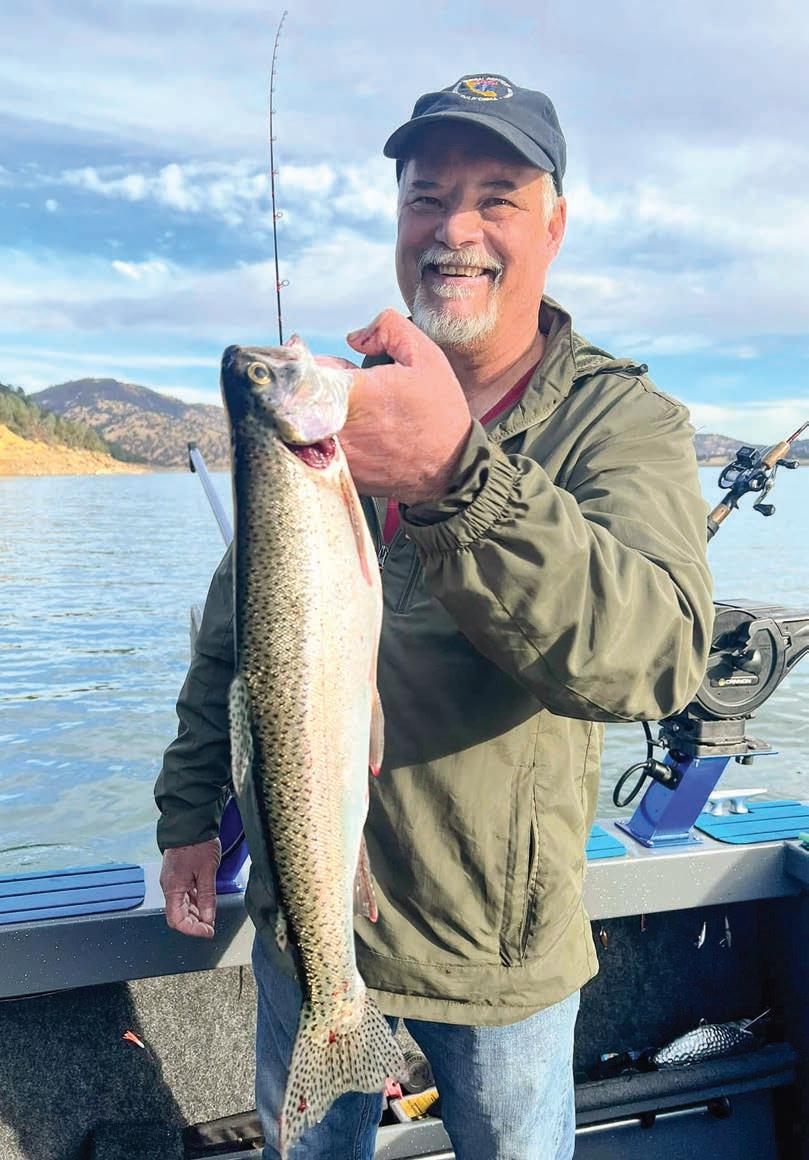
them we did!
By 11 a.m. we had three full limits of kokanee on ice. The 15- to 16-inch battlers were chrome bright and sported bright-red flesh. Our top offerings were small orange and pink hoochies teamed with 6-inch, 24k gold Catch America dodgers trolled from 1.2 to 1.4 mph.
The fish were scattered in terms of depth, and we hooked them anywhere from 40 to 65 feet deep. Thomas tipped our lures with shoepeg corn dyed and scented with products from Northwest Bait & Scent. The hot scent of the day was tuna belly.
When I asked Thomas how 2025 was shaping up in terms of kokanee
fishing at New Melones, this is what he had to say:
“Cal, it doesn’t get any better than this. We’ve already seen a few fish just short of 18 inches, and we are just getting into the good part of the season. We’ve been getting limits every day. We will certainly see 20-plus-inch fish this season,” he told me.
“As good as the action is now, it’s going to get even better as the surface temperature climbs and the thermocline gets more defined. This will cause the kokanee to lock into a narrower depth range, and they will begin forming tight schools. When that happens, the challenge won’t be hooking fish; it will be keeping rods in the water because the bites will come as fast as you can drop the gear,” Thomas added.
Beyond the epic fishing, New Melones offers a scenic and peaceful escape. Located near the historic gold rush towns of Sonora and Angels Camp, the reservoir is surrounded by rolling hills, oak woodlands and chaparral slopes that are home to wild turkeys, deer and golden eagles. Campgrounds, boat ramps and dayuse areas managed by the Bureau of Reclamation provide easy access to the water, while interpretive trails and historic sites tell the story of the region’s mining past.
Whether you’re chasing kokanee at sunrise, pitching jigs to rocky points for bass, night fishing for channel cats or trolling for a slab rainbow on a misty winter morning, New Melones Reservoir stands as one of Northern California’s most consistent and rewarding fisheries. Its size, structure and seasonal variation ensure there’s always something biting and always a reason to come back.
If you’re planning a trip to the Sierra foothills with a rod in hand, put New Melones at the top of your list. It’s a reservoir built on history and sustained by angling passion. CS



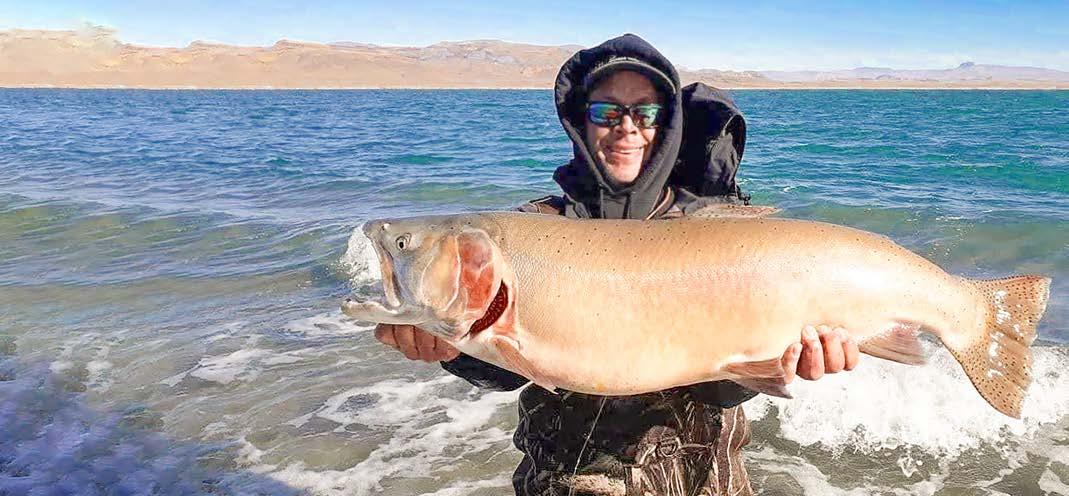
Fireworks are available for purchase at our three store locations: I-80 Smokeshop at Exit 43, Nixon Store at the junction of SR 446 & 447, and the Pyramid Lake Marina, located at 2500 Lakeview Dr.
**Permits for summer camping, boating and jet skiing available at Pyramid Lake Marina and the Ranger Station,


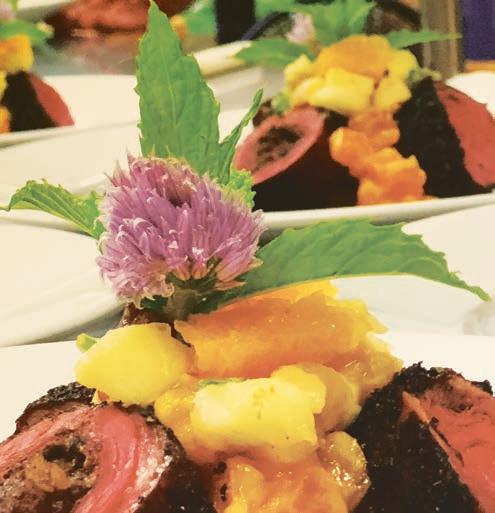

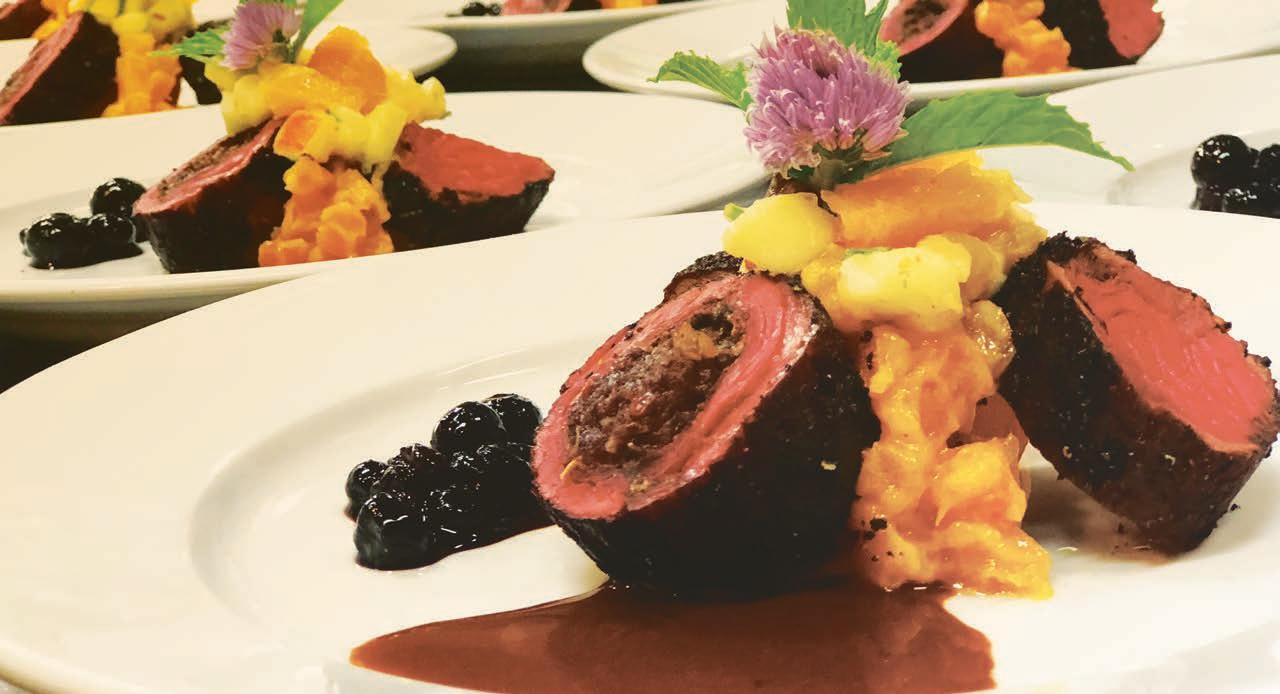




Whether it’s spotted bass or jumbo catfish (below) – not to mention feisty panfish – Cal Kellogg says summer is a great time to hit Central Valley and Sierra foothills lakes for some freshwater potluck action. (CAL KELLOGG)
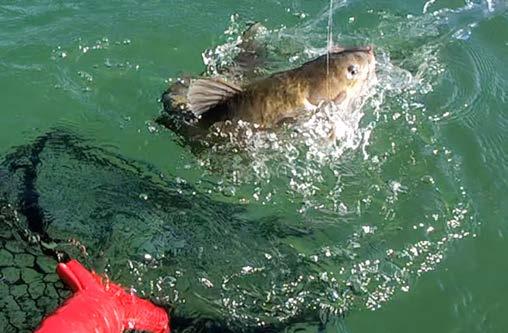
By Cal Kellogg
Iknew the lake held jumbo 1-pluspound bluegill, as I’d caught a few of them in the past by accident. But now that I was specifically targeting them, I realized I didn’t know much about bluegill behavior or how to catch them.
When bluegill are spawning, fishing for them is easy. You simply fish shallow structure and near-shore
cover with a worm and bobber. But now it was June, the spawn was long over and the panfish had abandoned their near-shore haunts. In short, I was stumped. I figured the fish had moved deeper, but I had no idea how deep they’d gone, or specifically where they’d concentrate.
Voilà! I had an idea. I armed my spinning rod with a double-hook drop-shot rig and put a small plastic worm on the lower hook and pinned
a lively jumbo red worm on the upper hook.
With this rig I could pitch up into shallow water and work down the slope, moving ever deeper until a bluegill grabbed the worm. As a bonus, I’d undoubtedly hook a bass or two on the soft plastic bait.
Six casts into the experiment, and with the rig sitting in about 15 feet of water, I got the sensation of pressure, followed by a couple pumps of the
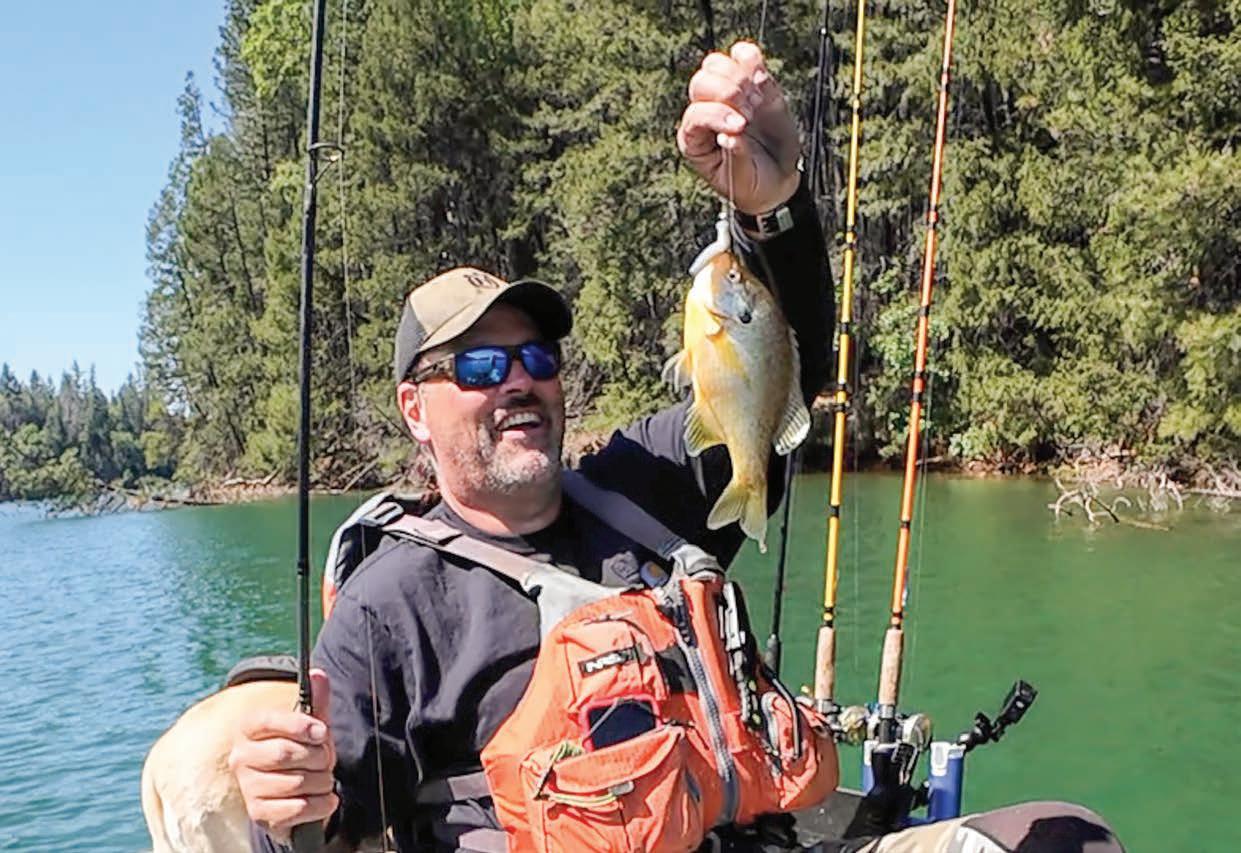
rod tip. I reeled down, jabbed the hook home and was fast to what I assumed was a spotted bass.
The fish surged downward with ever increasing power.
“This must be a good-size bass,” I thought as the tip of my spinning rod was pulled down into the water.
A few minutes into the stalemate, I concluded the fish was either a spot of gigantic proportions or I’d hooked a catfish. When steady pressure finally brought the monster to the surface, my suspicion was confirmed. It was an 8-pound channel cat sporting a sleek, muscular physique!
I’m sure the fish would have made for great eating, but I wasn’t out for meat, so after admiring the handsome whiskerfish, I slid it back into the water and watched
it disappear back into the depths. Catching that monster on light spinning gear was a great thrill!
Trout, trout and more trout is part of who I am. I guide for them and create new and innovative trolling tackle, and I’m constantly filming fishing content for my YouTube channel.
Yet trout are only part of the story when it comes to fishing Northern and Central California reservoirs. Our reservoirs offer outstanding bass fishing – that’s a given – but there are also crappie, jumbo bluegill and catfish in the mix. Often when I’m out chasing trout, my mind turns to warmwater species and I find myself contemplating if there are bluegill on that bank, crappie hiding
in the limbs of that fallen oak tree, or if the big mark I see hugging the bottom on the sonar unit is a huge channel cat.
Man doesn’t live by trout and salmon alone! Once in a while it’s fun to change things up with a little action in warmer water. Summer is prime time for what I call foothill potluck fishing.
When the surface water temperature at our foothill impoundments hovers between 70 and 80 degrees, trout and salmon will have dropped into deep water, and the top 30 feet of the water column is the playground of panfish, bass and catfish.
I’m not suggesting you stop trout fishing during the summer. On the
contrary, I’m thinking you should add some potluck-style action to your fishing to-do list. If you’re curious but don’t know where to begin, keep on reading, because I’m going to break down the basics of targeting the bass, panfish and catfish that inhabit most of our valley and foothill reservoirs. These fish can be caught all year long, but I’m going to focus on how to hook them during the summer and on into the fall.
Spotted bass are one of the most consistent and accessible gamefish in Northern California’s deep, clear reservoirs. Known for their aggressiveness and willingness to bite, spots are especially active during the summer and early fall, but catching them consistently requires an understanding of their seasonal behavior and habitat.
During summer, spotted bass often suspend off main lake points, rock walls and underwater islands in 15 to 30 feet of water.
Spots gravitate toward structure near deep water, where they can feed on baitfish like threadfin shad, but they still retreat to cooler depths. Electronics are critical this time of year, so look for bait balls, isolated rockpiles and arches near ledges. Spotted bass often school tightly, so work the area thoroughly once you hook one.
Effective presentations include drop-shot rigs with 3- to 4-inch finesse worms, Ned rigs, small swimbaits and shaky heads. Natural colors like green pumpkin, oxblood and morning dawn work well in clear water, while slightly more vibrant options like chartreuse shad can draw strikes in lower-light conditions. For suspended fish, try vertically jigging spoons or running underspins through bait schools.
In the early fall, as surface temps cool slightly, spotted bass become more active in the mid-depth range. They push shallow in low-light hours and can be caught on topwater baits
like walking-style lures, poppers and buzzbaits early in the morning or late in the evening. During the day, they often return to mid-depth structure or suspend in deeper water.
Unlike largemouth, spotted bass often school up in large numbers and will compete for bait when the bite is on. Keep a follow-up bait ready when fishing reaction lures – think a quickly pitched drop-shot rig or soft jerkbait – so as to convert missed strikes into hookups.
From Shasta and Oroville, to Don Pedro and New Melones, spotted bass offer reliable summer action. With the right electronics, scaleddown tactics and a willingness to fish deep, anglers can put together impressive numbers even when temperatures sizzle.
Crappie fishing in Northern California reservoirs can be surprisingly productive during summer and early fall – if you know where to look. While springtime sees crappie stacked in shallow coves and brush for spawning, the summer heat
pushes them deeper, often into hardto-reach holding zones.
In summer, crappie typically suspend in 15 to 35 feet of water near structure such as submerged trees, brush piles, creek channels and the edges of main lake flats. Look for shade, cover and thermocline breaks. Electronics are key, as schools often appear as tight clusters near vertical structure. Bridge pilings and steep bluff walls are also prime areas.
Small jigs in 1/16- to 1/32-ounce sizes are staples, especially those with tube bodies or curly tails in white, chartreuse or natural shad patterns. Slow vertical presentations are often most effective. For deeper schools, try tightlining or using a slip bobber to suspend your bait precisely at depth.
Live minnows are also highly effective, particularly when fish are tight-lipped. Rig them under a slip float or on a light drop-shot rig to hold them in the strike zone longer.
During early fall, crappie often follow bait schools into shallower water during low-light periods. Dawn and dusk can offer excellent action near shoreline cover or
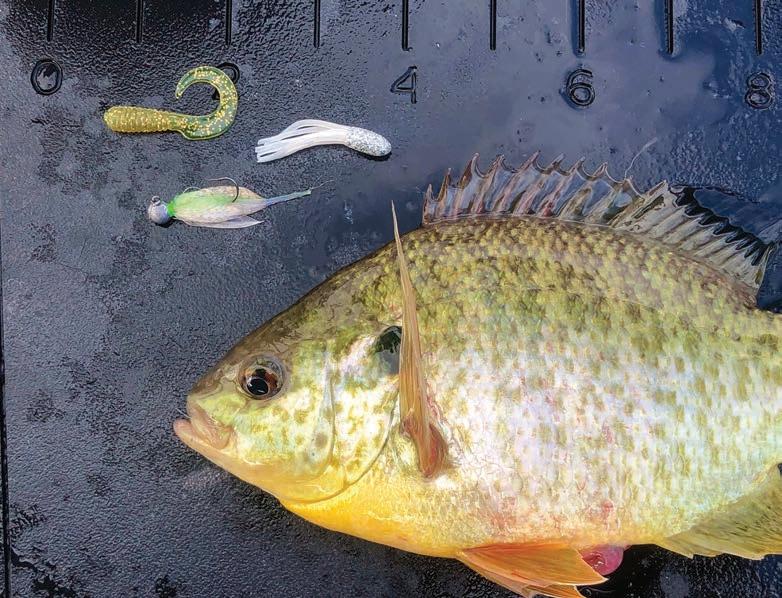
docks. Keep a rod rigged with a small crankbait or Beetle Spin for roaming fish.
Whether you’re fishing from a boat, kayak or the bank, crappie remain a year-round option – if you’re willing to adapt and fish where the fish are.
These panfish are one of the most accessible and consistent fish in Northern California reservoirs during the summer and early fall. Bluegill thrive in warm water and are plentiful around submerged structure, making them a great target for anglers of all ages.
In summer, bluegill typically move deeper as surface temperatures climb. Look for them in 8 to 20 feet of water, especially near submerged brush, standing timber, rock piles or dropoffs close to shallow flats. Areas with shade – such as overhanging trees, docks or bridge pilings – are also prime holding zones.
Small jigs in the 1/64- to 1/16-ounce
range work well, especially those tipped with soft plastics like grubs or nymphs in natural colors (brown, green or pumpkinseed). Suspend them under a bobber or fish them slowly along the bottom.
When the bite gets tough, switch to live bait. Redworms, mealworms and waxworms fished under a float are bluegill favorites and often outfish artificials.
During early fall, as temperatures cool slightly, bluegill become more active again in the shallows, particularly during early morning and late evening. Weedlines, gravel flats and the edges of coves can hold good numbers of fish during these windows.
Ultralight spinning gear with 2- to 4-pound-test line offers the best balance of stealth
and sport. From shore, kayak or boat, bluegill offer nonstop action, and they are great for introducing kids to fishing or filling a cooler for a classic fish fry.
Cats thrive in Northern California’s reservoirs, and summer through early fall is prime time to catch them. As water temperatures climb and baitfish become more active, catfish move into predictable patterns that make them accessible for anglers fishing from both shore and boat.
During hot summer days, channel cats typically hold deep – 15 to 40 feet – around creek channels, submerged ledges, dropoffs and the base of steep, rocky points. These zones offer cooler water and plenty of forage. As evening approaches, catfish begin to roam and move onto flats, shallow coves and mud-bottomed areas to hunt for food under the cover of darkness.
Night fishing is especially productive. Channel cats are
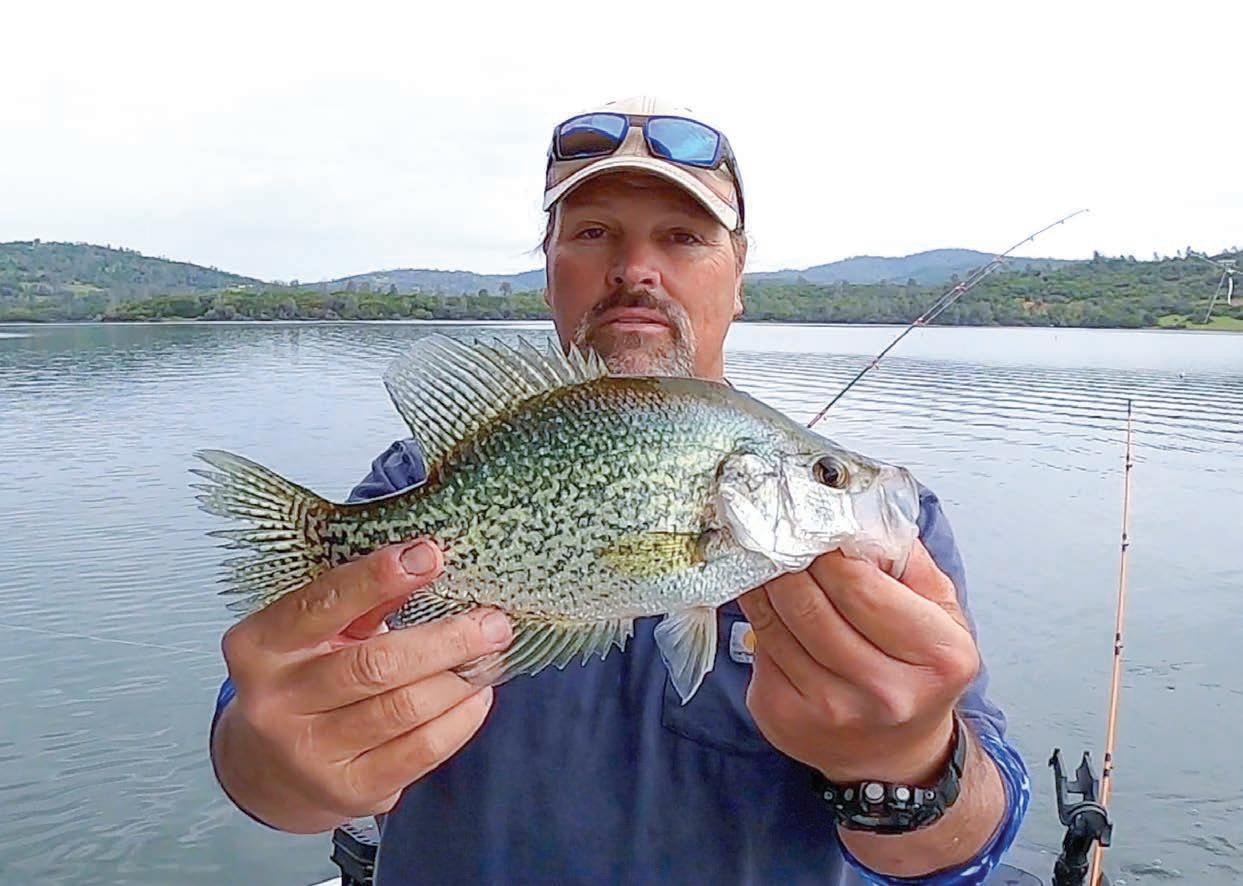
Crappie are often elusive this time of year, but if you put in the time to find them, the rewards are exciting and their delicious filets are great for your table. (CAL KELLOGG)

For destinations found on a map, or ones that are simply a state of mind, trust a reliable Honda outboard to get you there. And back. Find out more at marine.honda.com or visit your Authorized Honda Marine Dealer.

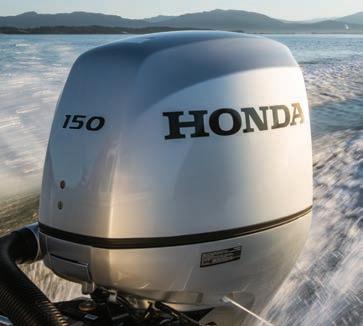
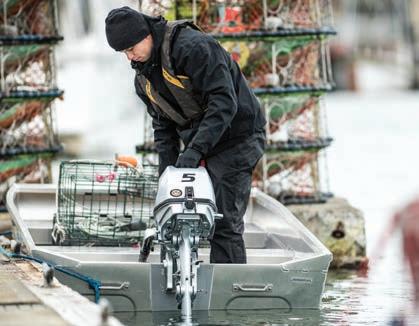


If trout and landlocked salmon aren’t biting as frequently as you’d like this summer, Kellogg says to look into the bass, channel catfish and panfish action. “They will put a smile on your face and a bend in your rod,” he writes. (CAL KELLOGG)
nocturnal by nature and feed most aggressively between dusk and midnight. Look for areas where shallow water meets deep access. Spots near creek inlets, submerged timber or rocky outcroppings with adjacent flats are ideal.
Freshly cut bait is the go-to offering. Anchovies, mackerel, sardines and chicken liver are highly effective, as are shrimp and crawdad tails. A sliding sinker rig with a 1/0 to 3/0 circle hook is perfect for keeping bait on the bottom, while also allowing a catfish to take it without feeling immediate resistance. Many seasoned anglers also use stink baits or dip baits in warm conditions, when scent dispersal is key.
Bring a lantern, glow sticks and a good rod holder setup if you’re fishing after dark. Keep your gear quiet and don’t hesitate to move every 30 to 45 minutes if you’re not getting bites.
Popular reservoirs like New
Melones, Berryessa, Folsom and Oroville consistently produce quality channels this time of year. While most fish run 2 to 8 pounds, doubledigit cats are always in the mix, especially for anglers who commit to fishing big baits in big-fish zones. For simplicity, action and tasty filets, summer catfish can’t be beat.
If you feel like you’re mired in trout and salmon doldrums after the fast and frantic trout action you experienced during the spring, I strongly encourage you to give some of our prolific warmwater species a try. They will put a smile on your face and a bend in your rod. You can thank me later! CS
Editor’s note: Cal Kellogg is a longtime Northern California outdoors writer. Subscribe to his YouTube channel Fish Hunt Shoot Productions at youtube.com/ user/KelloggOutdoors.


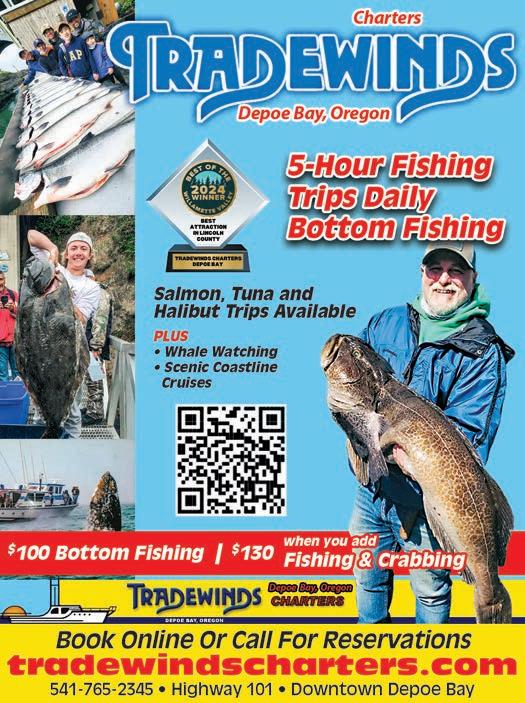

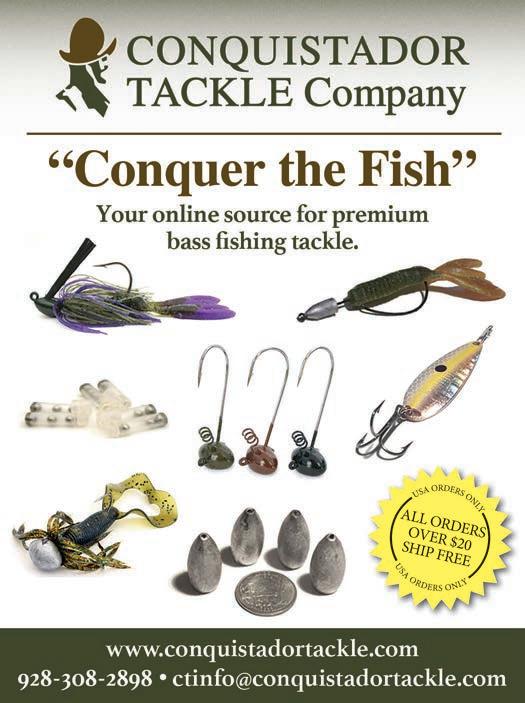





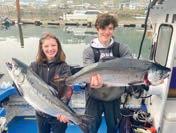
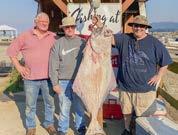



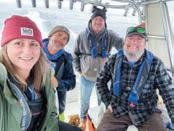

FOR THE FIRST TIME SINCE 2022, CALIFORNIA HAS AN INLAND SALMON SEASON, AND IN CASE YOU FORGOT, HERE’S HOW TO CATCH ’EM
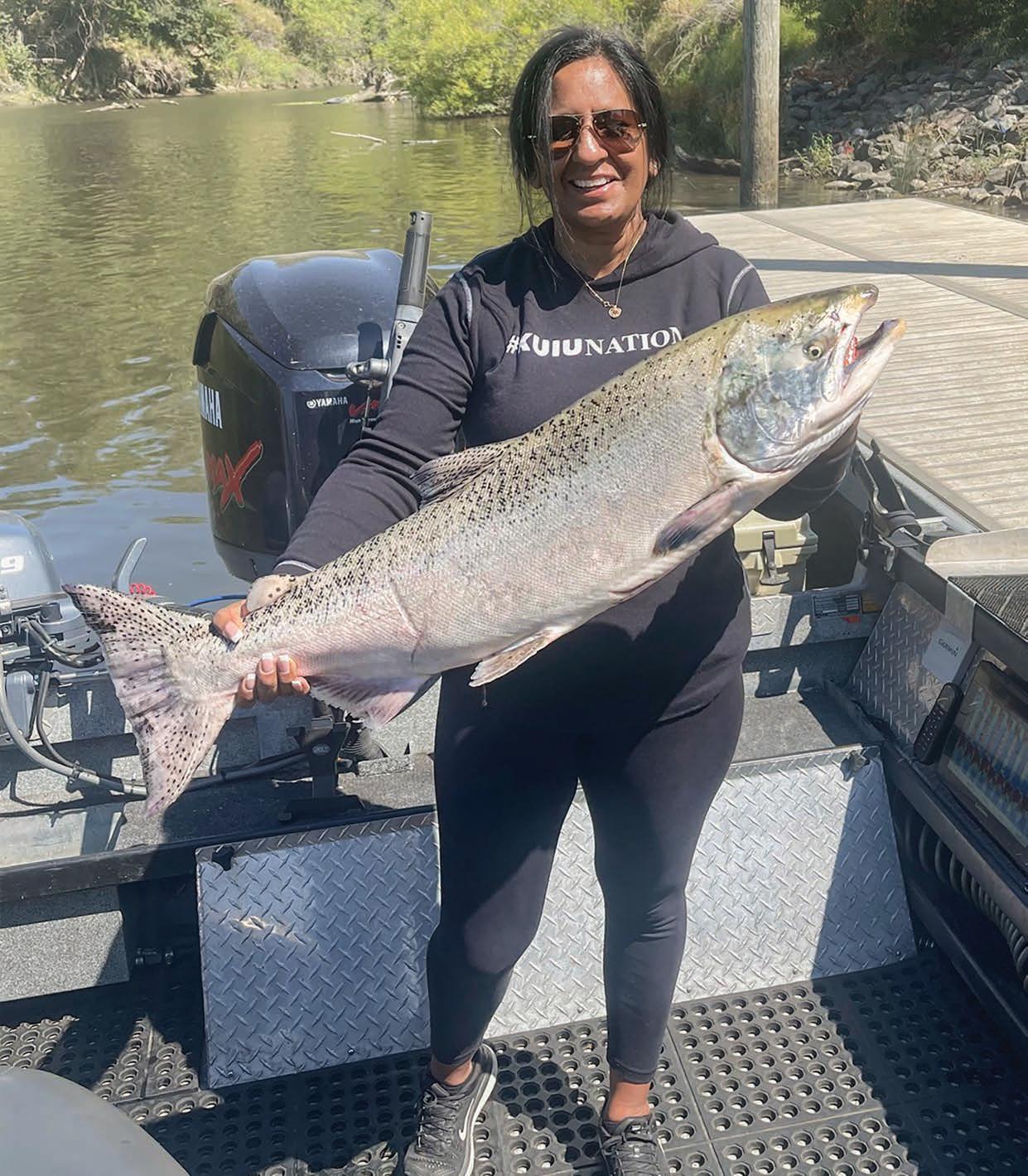
By Mark Fong
For California’s inland salmon anglers, 2025 brings both good and bad. First, the good news: Specific sections of three inland Central Valley Rivers – the Feather, American and Mokelumne – are scheduled to reopen on a limited basis for sport Chinook fishing for the first time since 2022. The limited season is slated to open on July 16, with adjusted seasonend dates for each specific section of river and a daily bag limit of one fish.
Unfortunately, the bad news is that the Klamath River Basin and the Sacramento River and its other tributaries will remain closed. (As California sportfishing regulations are subject to change during the year, please visit the California Department of Fish and Wildlife website – wildlife.ca.gov – for a full description of the latest updated regulations, including the limited 2025 salmon season, to ensure compliance with the rules.)
With the start of the river season on the horizon, we checked in with veteran Northern California multi-species guide Brandon Abernathy of Rod Down Guide Service to get his thoughts on the return of the river salmon season. In the process, Abernathy shared some great tips and tactics that
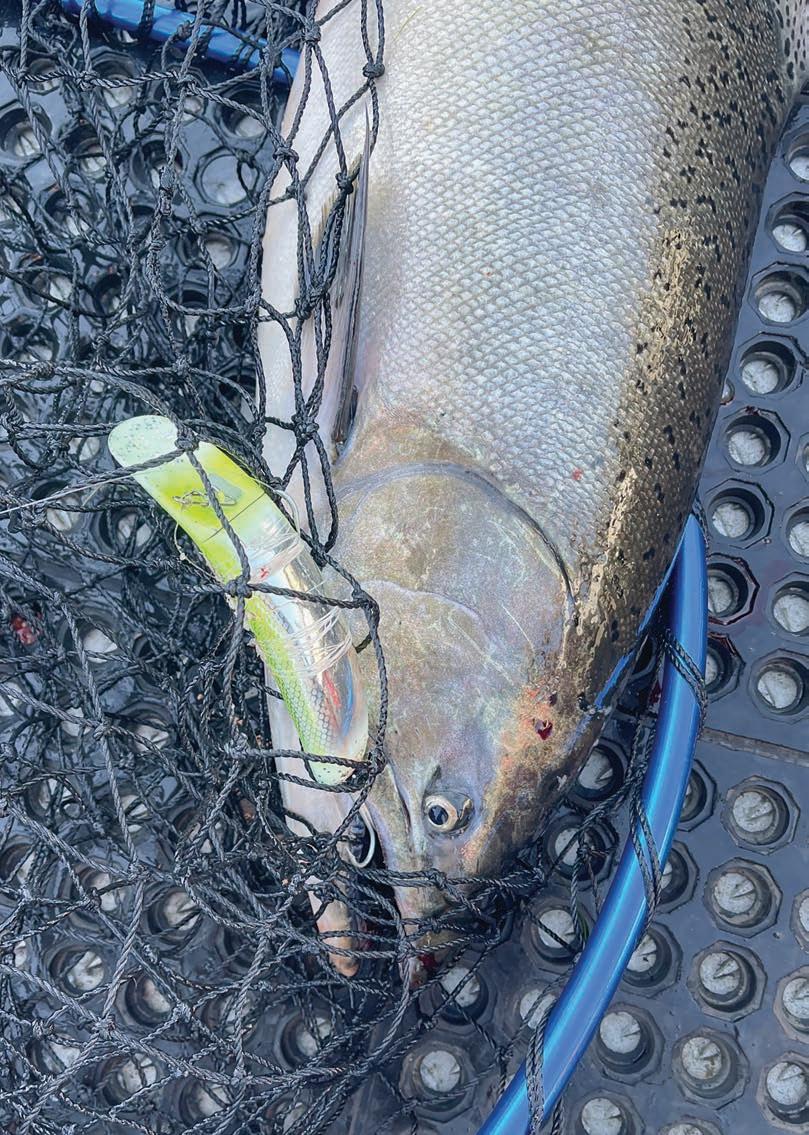
are sure to help anglers put salmon in the boat.
“I am extremely excited we are going to have a river salmon season,” Abernathy says. “It is something that I am very passionate about. It’s just something I like to do and I look forward to it every year. Even though it is a limited season, I am super excited to get back on the

clients’ efforts from Gridley north to the Outlet Hole, mostly the deeper holes and the runways,” he says. “It will be a two-prong approach: backbouncing with a Brad’s KillerFish plug and side drifting with roe.”
During the early season, Abernathy likes to target salmon with KF15 and KF16 KillerFish. He has a textbook setup, which features attaching a KillerFish to the end of a 3-foot leader of 50-pound P-Line monofilament. Abernathy ties a barrel swivel onto the other end of the leader. On the main line coming from the rod, he adds a sliding snap swivel tied to an 8-inch dropper with, typically, 1 to 2 ounces of weight.
Back-bouncing sardine-wrapped plugs has long been a go-to approach for California’s inland kings. (ROD DOWN GUIDE SERVICE)
river. Hopefully we see a lot of fish and catch a lot of fish.”
With the closure on the Sacramento River remaining in place, Abernathy’s game plan is to concentrate primarily on the Feather River and, to a lesser extent, the Mokelumne.
“This season I will focus my
The purpose of the additional weight is to help the lure get down near the bottom where the salmon are holding. The main line is then tied to the open side of the barrel swivel on the leader.
While Abernathy recommends dragon fly II and Kenai rainbow as good KillerFish patterns, he also believes that colors can be overrated.
“To me, color doesn’t really matter; I use the lure that has been hit the most or is torn up,” he adds. “It might be missing color but (fish) like the action of that specific lure.

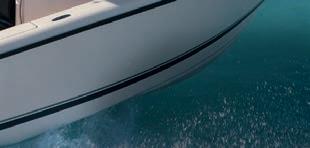


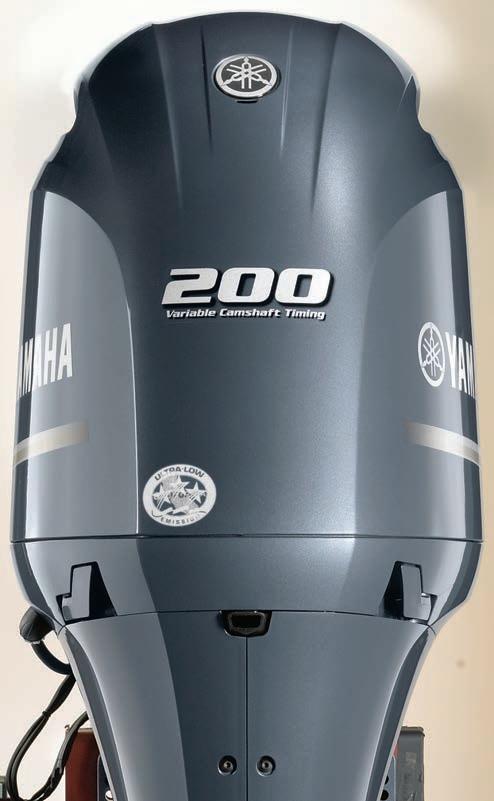
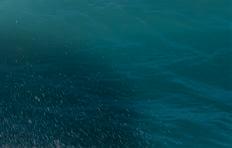
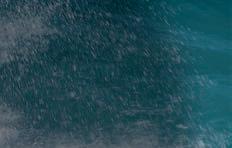






Want a more natural setup? Try side drifting with cured roe. A well-orchestrated casting order in the boat is critical for anglers to avoid tangles. (ROD DOWN GUIDE SERVICE)
Some lures have that special action the fish like better. When you find a bait that works like that, you better take good care of it. And, of course, don’t forget the sardine wrap.”
KillerFish come either with rattles (KF models) or without (KFNR), and it’s important to experiment to see what the fish want. Some days they want it rattling and other days they don’t. In addition, Abernathy adds a small barrel swivel to the back of the KillerFish between the rear hook hanger and the split ring.
This modification allows the hook to rotate and helps to prevent the fish from using the bait as leverage to pull away from the hook. Finally, Abernathy recommends changing out the stock hooks with quality after-market hooks like Gamakatsu or Owner.
“I’ll position the boat at the top of the hole and use my kicker motor to slowly back-bounce through the hole,” Abernathy explains. “The objective is to hold the boat either stationary in the current or to allow the boat to drift downcurrent at a pace that is slower than the current. All the while you are bouncing the weight off the bottom, which allows the KillerFish to move back and forth in front of the fish, drawing a reaction strike.”
Side drifting with cured roe is another very effective technique for targeting river salmon. It allows anglers to present their baits in a very natural way. Another benefit of side drifting is that it is a great way to cover productive water.
“Once the bow of the boat is positioned facing upstream at the top of the drift, the anglers cast at a 45-degree angle,” Abernathy says. “Casting order is very important. The angler at the back of the boat is the first to cast, followed by the angler directly in front. Each angler must cast just past where the last angler cast. This process is repeated until the angler in the front of the boat casts.”
While this is happening, the captain is manipulating the kicker motor to control the speed of the drift to ensure the boat is moving at the same speed as the current. The key to getting bit is to make sure that each bait looks natural as it drifts through the salmon’s holding location.
While side drifting is best performed on medium-action spinning gear, the leader setup is similar to the one used for fishing the KillerFish. Abernathy runs a sliding slinky weight onto the mainline before attaching it to the leader swivel. He also downsizes to a 3-foot leader of 15-pound monofilament, to which he threads on a pink or green Fish Pills float ball directly in front of a 1/0 octopus-style hook, which is tied on with an egg loop knot that helps the roe stay in place.
Salmon are strong fighters and can reach weights of well over 30 pounds. As a result, Abernathy knows having the right gear is important for success. For back-bouncing, he likes to use a 7-foot, 11-inch Edge Mag Pro MSR7114-1 paired with an Okuma Cold Water reel spooled with 50-pound P-Line braid. When side drifting, Abernathy opts for an 8-foot, 6-inch Edge BWS StR 865-2 fitted with an Okuma Ceymar 4000 filled with 15-pound P-Line monofilament.
Salmon anglers who book a trip with Abernathy shouldn’t be bashful about learning about the fish and fishery.
“If you come fishing with me, don’t hesitate to ask questions,” he says. “I am here to teach you; that’s my job. And finally, fishing is fun; you’re on the water; enjoy the boat ride; enjoy the day and experience the moment.” CS
Editor’s note: To learn more about Rod Down Guide Service, contact Abernathy at (707) 927-6745 or message him on Facebook (@Rod Down Guide Service). In addition to river salmon, Abernathy guides for trout, landlocked king salmon, kokanee and striped bass.
“I am extremely excited we are going to have a river salmon season. It is something that I am very passionate about,” guide Brandon Abernathy says. “Hopefully we see a lot of fish and catch a lot of fish.” (ROD DOWN GUIDE SERVICE)


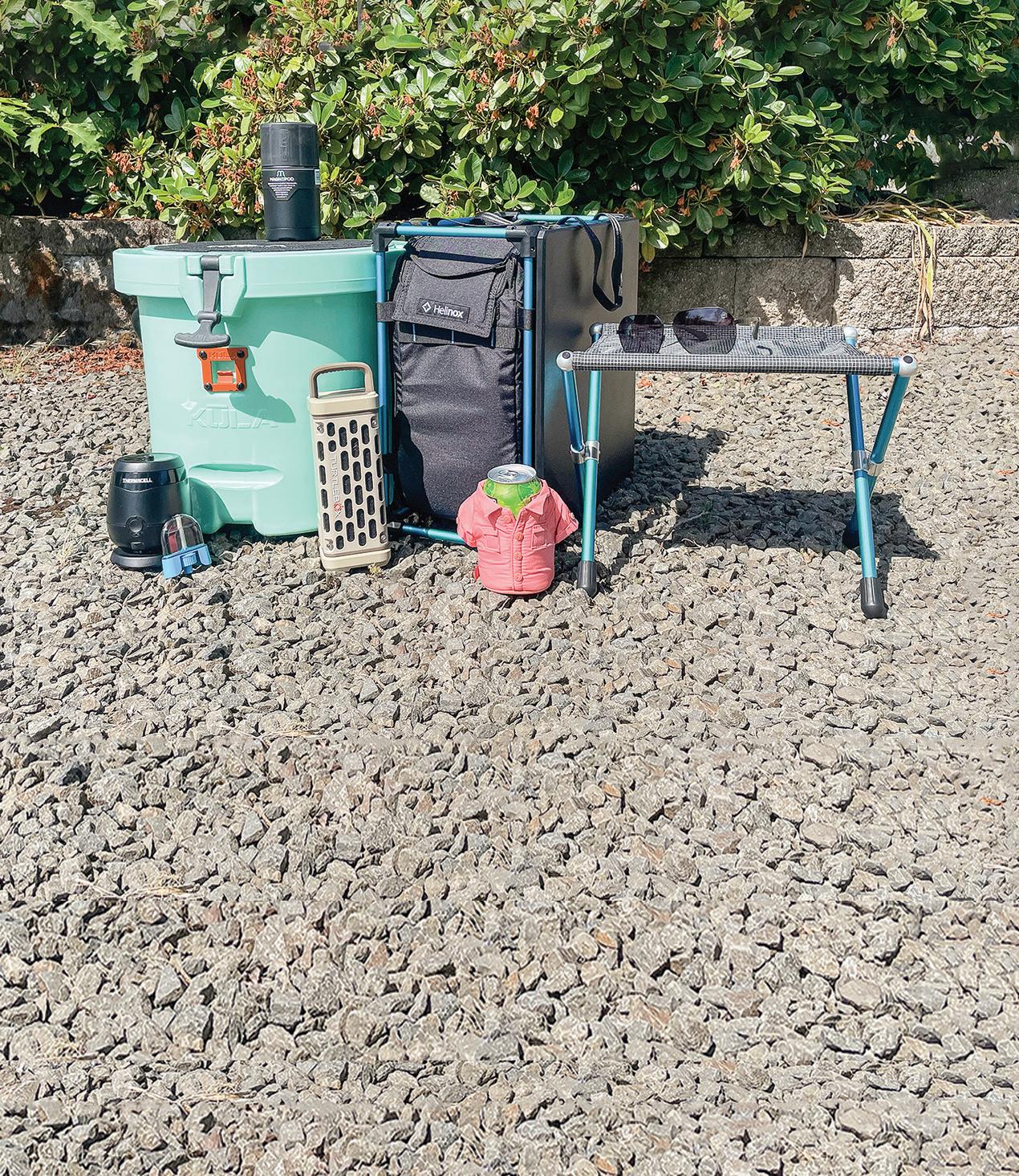
For everything from summer camping trips to backyard barbecues, this cooler, mosquito repeller and convenient table space to sneak in some work along the way are among new pieces of outdoor gear worth checking out.
By Scott Haugen
Summer means camping, and long days lead to more time outside. Whether you’re looking to head to the coast, hit the mountains or just enjoy backyard barbecues, here are some pieces of gear worth considering.
My first experience with a Turtlebox speaker came last winter when six buddies and I started setting a massive goose decoy spread at 2:30 in the morning in Northern California. It made the experience fun – so fun that I had to have one. I didn’t need the bigger Gen 3 model I’d first heard, so I chose their new Ranger. There are few pieces of outdoor gear I can remember liking this much; I use it almost every day.
I first took it to the duck blind, where I spent three hours doing postseason cleanup. I use it in the shop and during workout sessions, watering plants around the house, and while fishing and camping. Be it music or podcasts, listening is fun thanks to the clarity and portability of the Ranger. The magnetic mounts are ingenious, as are the other connective points and rugged design. It’s replaced several of the nearly half-dozen sound devices that have been plugged in throughout our home for years. Info: turtleboxaudio.com.
Twenty years have passed since I first used a Thermacell repellent unit. I was one of two outdoor writers who got to test and help in its development, and I did that for two years before it hit the market. Since then, I’ve used units

By Tiffany Haugen
Iknow it’s summer, which means you’re more likely to be putting fish in the freezer – and pushing that big game meat already in there to the back, where it sometimes gets forgotten about. But now is when you need to be cooking that meat up, making room for upcoming fall hunts.
This recipe first came to my attention while on safari in South Africa. It’s called shakshouka, and there seems to be as many spellings for this dish as there are ways to prepare it.
The camp cook took an impala I’d shot earlier that morning, chopped some roast meat and simmered it in tomatoes, onions and garlic. She added local spices and topped it with a poached egg. It was delicious. On a recent trip to Europe, I tried it again, but in a restaurant. This time the meat was pork and green olives were added to it. It was even better than I remembered.
I’ve made this flavorful dish many times
with a range of game meat. First up was venison, and everyone loved it. Then duck was used in the shakshouka, which also tasted great. I’ve made it with bear meat, wild boar and pronghorn, and every time it’s turned out wonderful.
1 pound chopped game meat
2 tablespoons olive oil
1 cup onion, chopped
4 cloves garlic, chopped
2 teaspoons curry powder
1 teaspoon salt
1 teaspoon red pepper flakes
1 cup tomatoes, diced
1 cup green olives, chopped
½ cup fresh parsley, chopped
Four eggs
In a large skillet, sauté onions and garlic over medium heat until translucent. Add curry powder, salt and red pepper flakes and sauté for one minute. Push onion mixture
to the edges of the pan; add another tablespoon of olive oil if needed. Add chopped game meat and spread out in a single layer. Increase to mediumhigh heat. Once meat begins to brown, turn over and brown the other side. Mix the meat and onion mixture together and add diced tomatoes. Bring mixture to a boil, stirring constantly for two to three minutes. Add olives and parsley. Decrease heat to medium-low.
Make four indentations in the meat mixture and crack an egg into each indentation. Cover and cook for three to four minutes or until eggs have set to desired doneness. Garnish with fresh parsley if desired.

Editor’s note: For signed copies of Tiffany’s popular book, Cooking Big Game, and other best-selling titles, visit scotthaugen.com.
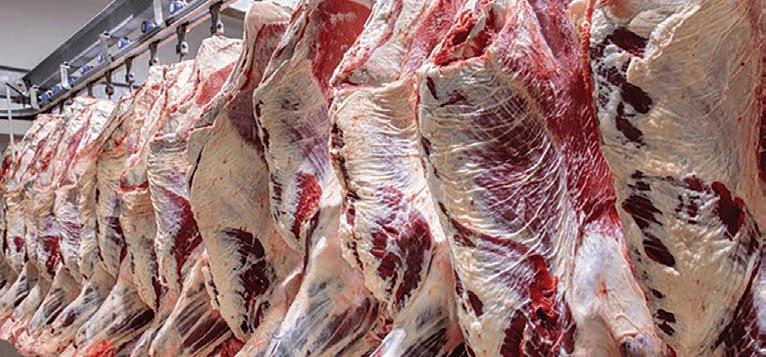
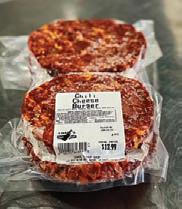
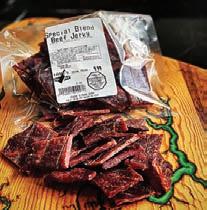

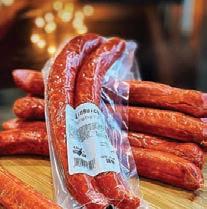
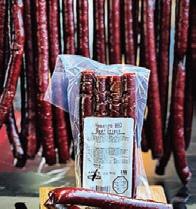






from Alaska to California, and across the country. I’m still using them, and the new E65 has me excited. It is a rechargeable repeller that’s great for camping or backyard barbecues. It takes only two hours to fully charge and runs for six and a half continuous hours, offering a 20-foot zone of protection. The repellent cartridge burns for 36 hours. The entire unit is airline travel-safe, as there is no butane cartridge like in previous models. It works great for mosquitos, no-see-ums and white socks, also known as black flies. Info: thermacell.com.
Some of the big coolers on today’s market are nice, but not practical when it comes to camping trips in parts of California. Enter the Bote Kula 5, which transcends traditional linear coolers – think 5-gallon bucket on steroids. The Kula 5 is extra sturdy and easy to carry. It works great as an extra seat – even for dry storage – and the Magnepod attachment point is great for magnetic accessories like drinkware, and even tools. Info: boteboard.com.
A fun accessory everyone in camp and on the boat seems to enjoy is Puffin Drinkware. I got a couple of their Skiff designs and they keep drinks cool. The Puffin line is extensive, making not only a great addition to your summer outdoor life, but they’re a fun gift idea. Info: puffindrinkware.com.
Sunglasses are a much-needed summer equipment accessory in sunny California. Timberland made their mark in the footwear world in the 1970s. Today, they’ve taken their top-notch reputation to the world of eyewear. When I first tried their pilot-style sunglasses I thought they’d be too big, but the more I wore them, the more I liked them.
The larger-than-normal frame not only blocks headwinds, but also inside glare from behind, plus the sides are greatly reduced compared to other wide-framed shades I’ve tried. They’re also polarized and great for fishing. Info: Timberland Eyewear can be found on Amazon.
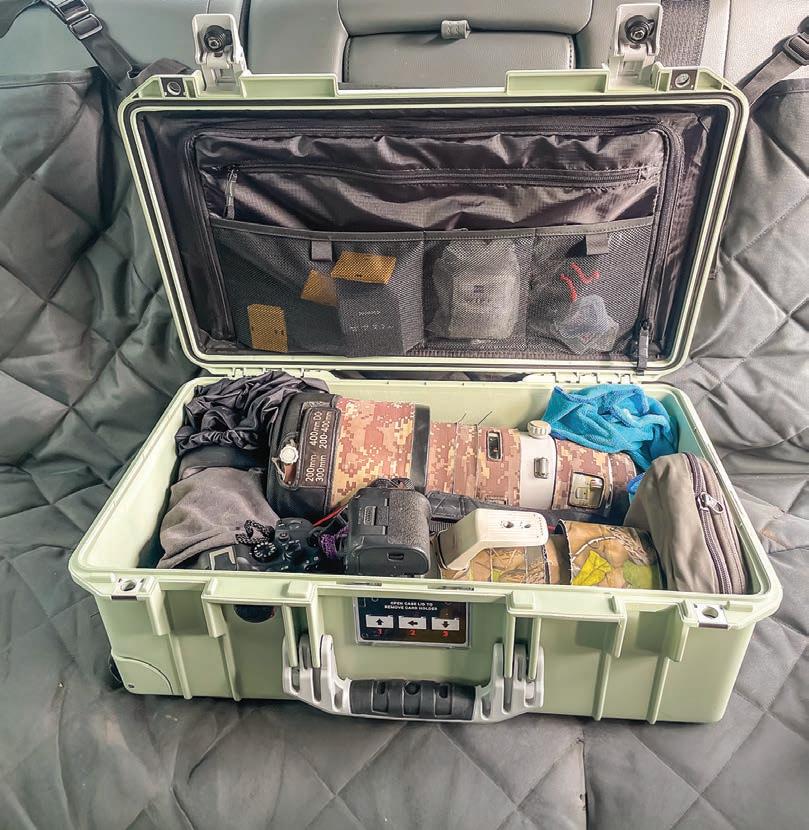
Being full-time outdoor writers, my wife and I do a lot of work in the field. She instantly fell in love with the Helinox Speed Stool because of its light, compact and sturdy design. It’s easy to toss in a backpack and sit in comfort to jot notes. It’s also handy around the campfire.
Tiffany got much use from the Helinox Outdoor Field Office too. This space-saving, all-inclusive storage and desk system is ingenious and sets up in seconds. The desk supports over 60 pounds and offers enough space for simple field jobs.
I first used it when checking trail cameras on a hot summer day. My tailgate was full of bulky gear and it was too hot to work in the cab. So, I broke out the Field Office, moved it to the shaded side of the truck, downloaded over a dozen trail camera cards to my laptop and backed them up on an external drive. If driving or boating to a camping location this summer and you need to devote a bit of time to work or recreational projects, this could be the answer for a compact, functional space. Info: helinox.com.
I’ve been a fan of Pelican cases for years, as the durability and


functionality of their storage cases and coolers are top-notch. Enter their 1535 Air Carry-On Case. In an effort to find a more reliable travel case for my camera gear, I chose this one. On my first trip the case held over $20,000 in camera gear, and everything traveled well and was fully protected.
The case is nearly half the weight of my previous one, meaning more gear can be carried. It’s dustproof and watertight, thanks to an efficient O-ring seal. It has a pullout handle, durable wheel system and an easycarry handle for the field. I recently customized the 1535 Air Case with Pelican’s foam padding. My video editor traveled flawlessly with camera and computer gear through five countries. Info: pelican.com.
Sea to Summit’s extensive line of lightweight travel accessories have been proven for years. On a number of outings my wife and I have enjoyed the performance of their Airlite and Drylite Towels, both of which are very absorbent, take up minimal space and are quick to dry.
Sea to Summit’s Aeros Ultralight Travel Pillow is comfortable and very compact. I’ve highlighted their dry bags in this column before, and they’re a great tool for a
range of summer outings. Info: seatosummit.com.
Yeti is known in the outdoor community for many great cooler and drinking container products, but did you know they have a line of cast-iron skillets? For 15 years a big part of my wife’s career as a full-time outdoor cook and recipe developer was traveling around the country delivering cooking seminars. She did a lot of cooking with cast iron. This winter she tested Yeti’s new line and has been using it ever since. From big game to fish, game birds to hearty breakfasts, she’s loved the even heat distribution of these skillets.
These cooking sources come preseasoned, are smoother than other cast iron she’s cooked with and easy to clean and maintain. The skillets work great over an open-fire gas stove, and Tiffany uses them a lot on both our home glass top and portable induction cooktops. Info: yeti.com.
There you have it: Some great items that can make your summer outings fun and efficient. All you have to do now is make time to get out and enjoy the outdoors! CS
Editor’s note: For signed copies of Scott Haugen’s popular books, visit scotthaugen.com. Follow Scott on Instagram.



Ever since scoring his first cottontail rabbit at 13 years old, author Tim Hovey (left) has looked forward to the July 1 opening of season in California. Now he annually targets these small mammals with buddies like Rito Escamilla. (TIM E. HOVEY)
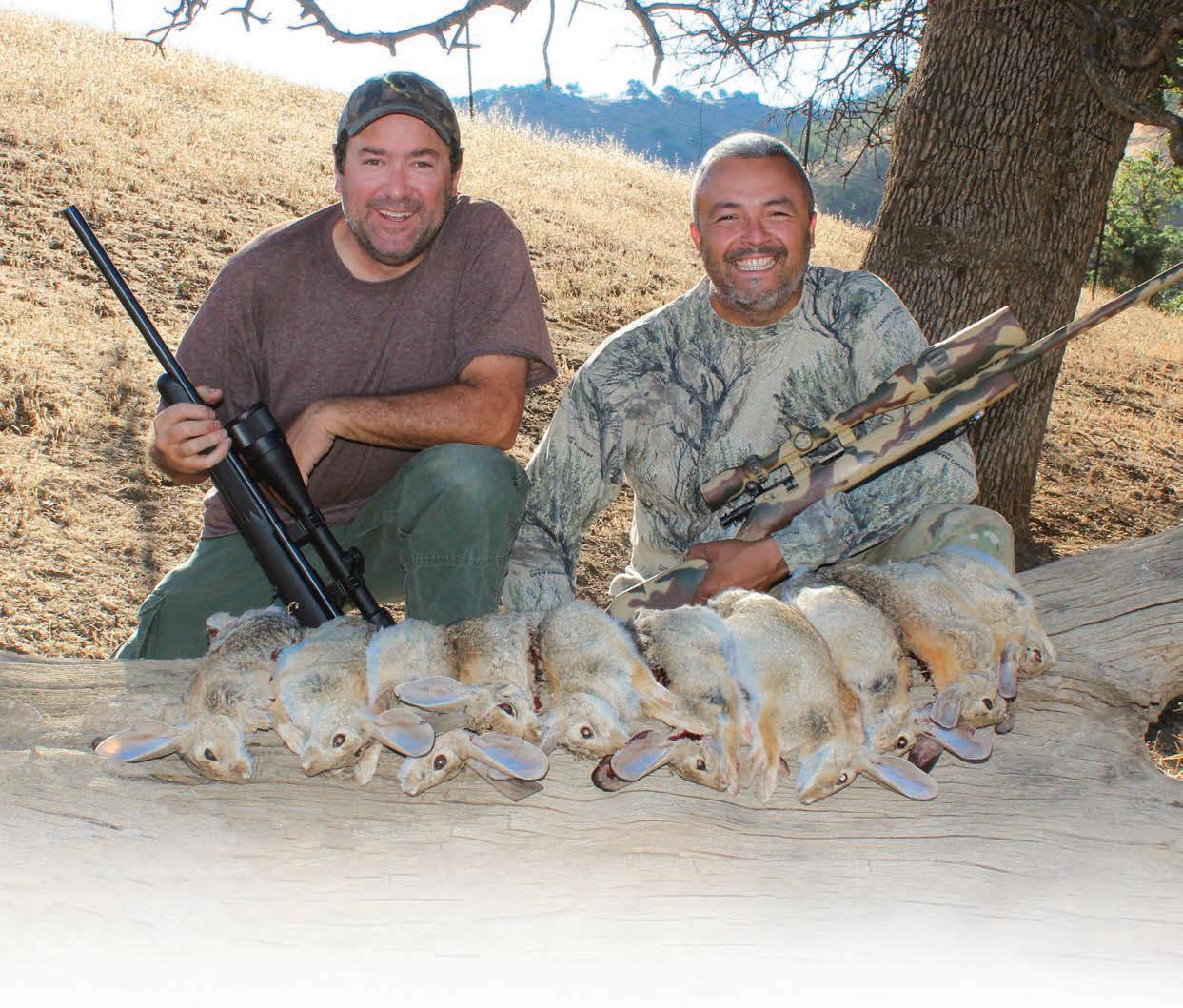
By Tim E. Hovey
Ileaned against an oak tree, facing a crease of sage 50 yards away and slightly uphill. Resting on my knees was a scope-mounted lever-action .22 I had borrowed from my dad’s cousin.
Minutes earlier I had surprised a jackrabbit while hiking near a drainage, and he had escaped to the sagebrush I was facing. A teenager at the time, I can remember thinking that I was willing to sit there all day waiting for him.
About 30 minutes later, a rabbit fed its way out towards
a small opening in the brush. My heart was pounding as I steadied the crosshairs on his shoulder. At the shot, I lost sight of the rabbit and hurried up the hill. I spotted blood where he had been standing and then found the dead cottontail a few feet away. It was my first game animal, and my first cottontail rabbit fell that day.
Many hunters start down the hunter’s path with small game such as rabbits. We learn subtle hunting techniques like stalking, patience and persistence. These attributes are honed over decades of pursuit and help us become better hunters overall. Along the way, we add in observation,
habitat recognition and specific game animal behavior. For me, it all started on that hillside at the age of 13.
IT DOESN’T MATTER WHAT I have planned; nothing disrupts my annual plans for the July 1 cottontail rabbit opener. The California cottontail season stretches almost seven months,
running from July 1 through January 25. The daily bag limit is five rabbits per hunter, with 10 in possession.
A month before the season opens, I make plans to scout a handful of tried-and-true spots. Time permitting, I’ll head out the evening before and camp so I’m on the hunting grounds at first light.

Cottontail rabbits are more active in the mornings and the evenings. Like most small animals, they are usually never far from a consistent water source. In the desert, I’ll look for green vegetation, which usually indicates a spring or watered creek close by. If I can find this type of habitat, rabbits will be close.
Thick vegetation, like sagebrush or rabbitbrush, routinely springs up in these damp areas, providing cover for rabbits
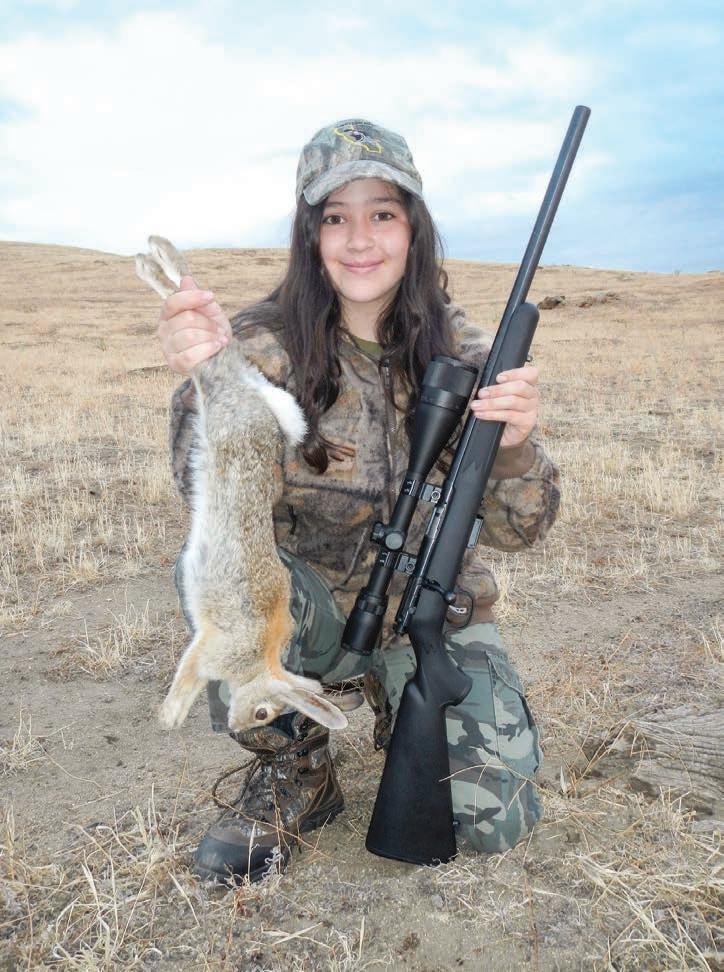
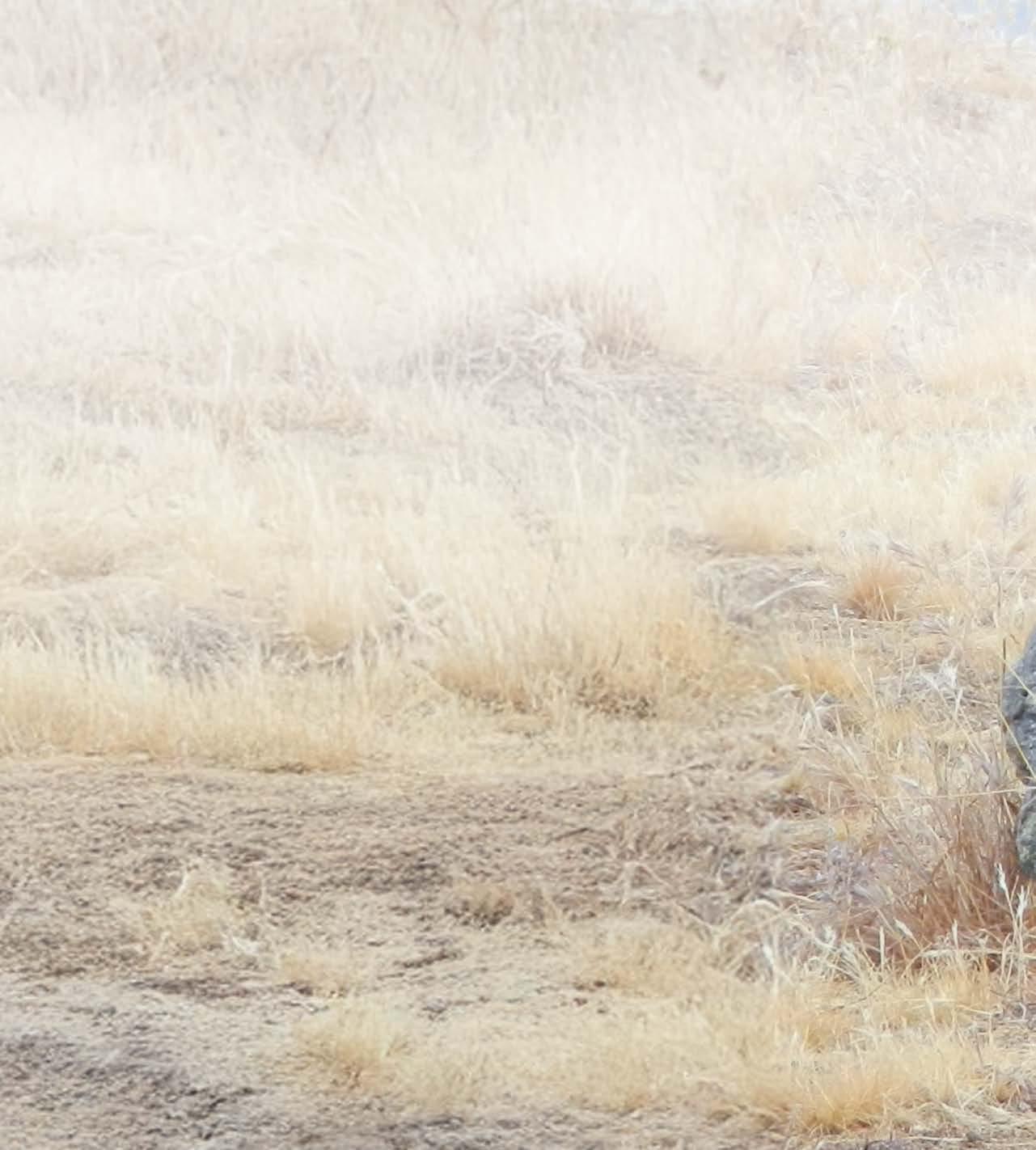
and protecting them from predators. They can also find some relief from the midday heat in the shade of the thick brush. Underground burrows are often hidden in these brushy areas, providing added protection from the heat and predation.
If these habitat types hold rabbits, they’ll usually be covered in rabbit scat and prints. Cottontails will hold tight in heavy cover when danger is close, then bolt for safety as a last resort. A quick walk through these brushy areas will tell you all you need to know when it comes to rabbit presence.
Probably the most common way to pursue rabbits is kicking the brush in good habitat with a shotgun. Keeping the sun at my back, I’ll move through the area, making sure that I contact



the brush with my leg as I walk through. Cottontails will often sit tight, racing for cover at the last second. This is the hunter’s opportunity.
I call this type of hunting snap shooting. Escaping rabbits won’t give a hunter much time to squeeze the trigger. Often, you only get a quick flash of fur, punctuated with that bright white cotton ball of a tail before they escape. This type of hunting will definitely sharpen a hunter’s instincts and shooting skills.
Another way I like to hunt cottontails is to set up on a high spot and glass for feeding rabbits just at sunrise. I’ll use a set of shooting sticks and the insanely accurate .17 HMR rifle; that way I can easily snipe bunnies out to about 150 yards. Again, I try to keep the sun at my back to hide my position a bit and have a better view of the terrain.
THESE HUNTS so fruitful is this: Rabbit is one of my favorite types of game meat. It’s a white meat that picks up the flavor of just about any marinade. My favorite way to prepare the meat is to butcher the rabbit into quarters and to pan fry the portions in olive oil until brown.
I then transfer the meat into a casserole dish with two cans of cream of mushroom soup. Cooked at 400 degrees until done, it’s one of my family’s favorite recipes.
This July, step back to where it all starts for most hunters and chase cottontail rabbits. For me, it takes me back to where I began this hunting journey. I remember all the things I’ve learned since leaning against that oak tree, mounted up behind a borrowed .22 lever-action. CS
Editor’s note: For more information on small mammal hunting in California, check out wildlife.ca.gov/Hunting/Small-Game.


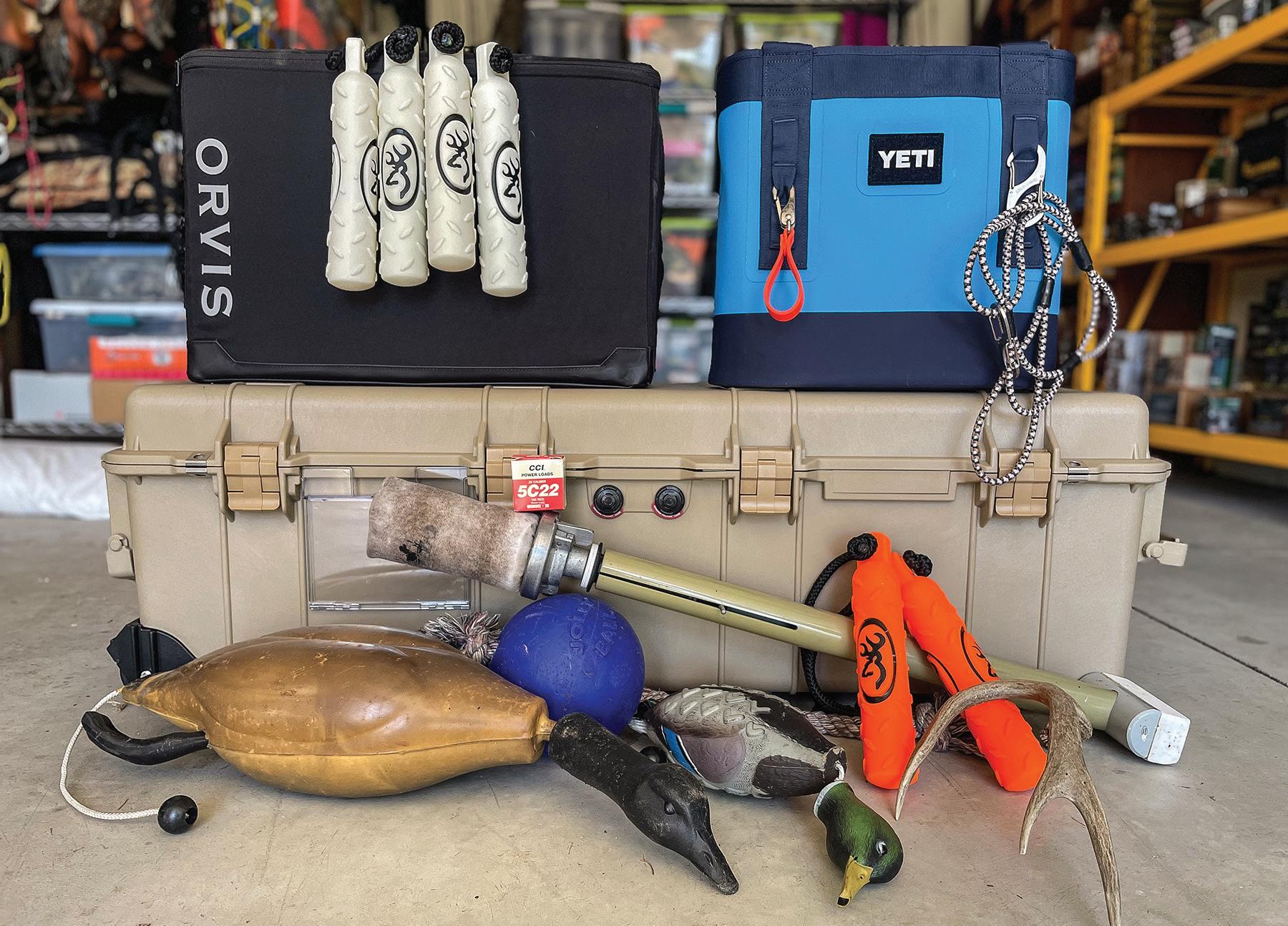
By Scott Haugen
Hot days and busy summer schedules. That’s what gun dog owners are up against this time of year. But the training must go on.
Over the last few years I’ve detailed summer training tips. In this column I’d like to share experiences I’ve had with important gear, stuff that not only works great now, but year-round.
LET’S START WITH ORVIS. I know what many of you are thinking: “Aren’t they the company that makes high-end flyfishing gear?” You’re right, they do. But they also make quality dog gear.
A year ago I picked up an Orvis Deluxe Dog Bed. My dogs use it every day, and it still looks new. Its quality is what spurred me to look at other Orvis dog gear.
We started with their Grip-Tight
Quilted Throw. After six months of daily use, this non-slip throw has not only protected furniture and couch cushions, but looks like it just came out of the box. It’s durable, stiff enough to where it won’t slide, but not so stiff that it’s uncomfortable or won’t conform to the surface it’s on. The chain of events continued.
Impressed with the throw, I decided to try their Grip-Tight Hose-off Quilted

Backseat Protector. I started using it last summer, when dirt, dust and seeds were tracked into the truck after seemingly every training session. Dry debris was easy to brush out. Then came the water test. The throw is marketed as one you can hose off to clean. After many training sessions in water and mud, I’ve hosed it off, hung it to air dry, reinstalled it and done it all over again. During duck season I often loaded the dogs wet, and the waterresistant coating on both sides worked perfectly to protect leather seats. I’ve owned lots of back seat covers over the years. This one has lasted the longest, and it’s tough enough my dogs’ toenails don’t begin to fray it.
A few years ago I traded in my Ford F-250 for a new F-150. The back seat of the F-150 was narrower and my
65-pound male dog couldn’t sprawl out and sleep; he tried and kept falling off. That’s when I got the Orvis Dog Seat Extender. Before I even got out of the driveway Kona laid down, rested his front paws and big head on it and relaxed. It’s the perfect fit for my truck and dogs.
ONE THING I CARRY year-round in my truck is a variety of clothes. It might be layers and rain gear during hunting season, while it’s usually lightweight clothing, hoodies, gloves and towels in the summer. I used to pile them into the truck’s back seat, but they always got mixed up, dirty from my dogs and were inconvenient to deal with. I tried stuffing them into duffel bags, but that wasn’t efficient either. Then I discovered Yeti’s Camino 50
Carryall Tote Bag. I loved it but wanted something smaller for the summer that I could stow less bulky clothes in, saving space, so I got the Camino 20. Whether I’m shedding layers in the morning or adding layers in the evening, the Camino 20 is great. It’s durable, stiff enough to stand alone, and the inside zipper pockets, deployable internal dividers and outer hitch points are well thought out.
If you’re the owner of versatile gun dogs like I am, you likely have a lot of training gear. And this time of year it can be challenging to keep track of it all. I used to have a bin filled with equipment in the back of my truck. Then one bin became two, and two, three. Early in the spring I converted to one large case and am glad I did. I initially got Pelican’s 1740 Protector Long Case with foam layers for my photography gear on road trips. But it didn’t take long for me to remove the foam and start using it for other purposes, like storing all my summer dog training gear. It fits a variety of bumpers – even large geese – collars, leashes, leads, a dummy launcher, bird launcher, bird bags, shed antlers and more.
It’s nice having all my training gear in one, stable container. I love the tough latches and wheels, and the sides don’t bulge, no matter how much weight and bulky gear I’ve put in there. It’s 100 percent dustproof, waterproof and easy to swap out with seasonal gear as needed, be it for hunting, fishing, camping or photo shoots.
While these days are hot and long, dogs have to be worked and kept in hunting shape. Train and condition them early in the morning and in the evening, when it’s cool. Keep sessions short and fun. By having the quality gear you need, training sessions and your dog’s daily life will be more efficient and manageable. Hunting season will be here soon. CS
Editor’s note: Scott Haugen is a full-time writer. See his puppy training videos and learn more about his many books at scotthaugen.com and follow him on Instagram and Facebook.

